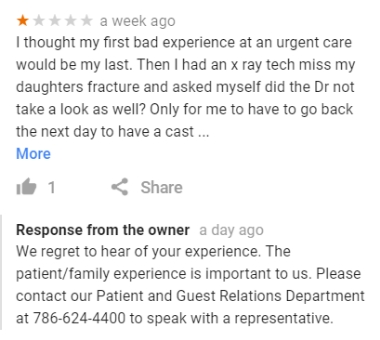A Complete Guide To Reputation Management For Healthcare Providers
Introduction
We’ve all seen them. They’re no secret. Negative reviews are a fact of life in today’s internet-driven America and they matter a whole heck of a lot when it comes to healthcare businesses.
A Complete Guide To Reputation Management For Healthcare Providers In The Modern Healthcare Market
The good news is that it’s not a mystery, we know how they work. We’ve all read negative reviews of various products and services. We know how that doubt about the quality and authenticity of a company can lead to a less than shining opinion of a business. In most cases, a bad reputation will send potential customers in search of another business to meet their needs. This is why reputation management for doctors, outpatient centers, clinics, and hospitals is critical in today’s healthcare market.

The Crux: Why This Matters
 If you work in healthcare (hint: if you found this book, you likely have some sort of vested interest), then you know that the industry is tumultuous, operating on razor-thin margins in many cases. Every healthcare provider, from PCPs to hospitals, is looking for a way to get a leg up on the competition.
If you work in healthcare (hint: if you found this book, you likely have some sort of vested interest), then you know that the industry is tumultuous, operating on razor-thin margins in many cases. Every healthcare provider, from PCPs to hospitals, is looking for a way to get a leg up on the competition.
The advantage that everybody has access to, but few utilize, involves proper reputation management. According to Zocdoc, a provider who increases his or her rating by just half of a star (3.0 to 3.5, for example, can expect about a 37% increase in monthly appointments. That’s a sizable bump.
Good reputation management leads to security and stability for any healthcare practice. And it’s a lot easier to achieve than you might think.
The Majority of Patient Concerns and Complaints Are Related to Quality
In short, good quality and customer experience management leads to a good reputation. It just grows organically out of that process. A smart office manager will actually find this to be pretty easy to implement. Skip ahead to the section dedicated to this for more details.
We’ll discuss the reasoning for this and offer a few tips and in-depth breakdowns of various elements and pitfalls throughout this book. Our goal – our hope – is to help physicians, hospital administrators, operations and marketing managers, business owners, and anyone else working in the medical industry to succeed.
There is a blatant truth that cannot be ignored about the reality of healthcare: front desk staff, billing staff, and doctors and nurses of all stripes and specialties are people who also have families and bills. The medical practices upon which they rely for their paychecks are businesses with overhead to contend with and a bottom line to meet.
Thus, we cannot hope to help medical practitioners without first helping the healthcare practices that they operate.

Chapter 1
Consumers Take Healthcare Reviews Seriously…seriously.
Healthcare is, arguably, the most important ‘purchase’ for most consumers. A new car may make you happy, but it doesn’t make you feel good in the same way that a clean bill of health does. In fact, it’s difficult to argue the opposite position for most people.
While the numbers will vary a bit from one survey to the next, the most recent consumer surveys typically show that around 70% of potential patients are strongly influenced by online reviews when they have to choose a new physician. One survey shows that 69.9% find a good rating to be very or extremely important; another says that 72% of patients use online reviews as their primary source of information when researching physicians.
70% Is Not A Small Number
In terms of the American population, that equates to 229 million people.
And yet, that number still doesn’t fully illustrate the weight that good reviews can have on this decision. Consider this: In one study, 48% of respondents, nearly half, stated that good reviews would influence them to go to an out-of-network physician over in-network doctors. Now, that number comes with a lot of shades-of-gray (i.e. how much better does the out-of-network doctor need to be; how bad does the in-network doctors need to be?), but even if we were to adjust that number down to 35%, that’s still one-in-three patients willing to pay a lot more (technically-speaking, I think the term is “heckuva lot”) for a doctor who simply has a better online reputation.
Why?
When the quality of a medical office which we plan to take ourselves or a loved one to is in question, the importance of finding better alternatives is incomparable. With a new phone charger or a lawn service, we’re willing to take a little bit of a chance. Perhaps that reviewer seems a little high-strung or over-dramatic; or maybe, since the review is seven months old, the particular guy who did that lawn isn’t there anymore.
Most importantly…
Decisions about where to go for medical care are perceived as more important to consumers than decisions about purchases in other industries.
Healthcare is your life, your well-being, your future and the memories that you have yet to make. The difference between researching the best headphones for your budget and the best doctors for yourself and your family is an apples-to-durian comparison. Sure they are both fruits, but that’s about as far as the similarities go.
If you’ve found MedRev, chances are good that you work in healthcare and you are already aware that your reputation is important to your business. The discussion we’re embarking on is your reality; waiting rooms are your trenches and negative patient reviews make your heart sink into your stomach because you know the repercussions. One negative review can hurt – a lot of them, especially if they all corroborate the same issues, can send your practice into a death spiral.
Online Reviews Are The New ‘Word-Of-Mouth’
Let’s assume that Fred has ten close friends. Eight of those friends like their doctors, but those eight friends see six unique primary care physicians. Well, Fred certainly isn’t going to go with the two who were disliked, but how does he choose between the six?
It’s very likely, at that point, that Fred will simply look over the locations for all six and figure out which is most convenient, since location is typically one of the most important factors for people looking for a new physician.
Online reviews, however, expedite this process. Instead of ten people giving opinions, a potential patient today has access to hundreds of reviews for each potential physician. Ask any scientist: hundreds of data points are a lot more revealing and reliable than one or two. Inside of an hour, a patient can easily cross-reference:
- Average review score
- Total number of reviews
- Positive and negative reviews to check for trends
- Location
- Office hours
- Credentials
For a dozen physicians.
Depending on the practice’s website, they may even be able to check on whether their insurance is covered without having to call.
In short, a strong online presence is a huge leg-up for the physicians who embrace it.
What are physicians doing to manage their reputations?
Unfortunately, the current state of the healthcare market does little or nothing to mitigate the ever-rising importance of reputation management for doctors and their practices. Physicians are left scrambling to figure out how to avoid bad reviews, or searching for how to address a negative review once their website is on the internet for the world to see.
And that’s not the worst case scenario. Most doctors and practice managers are already stressed out with the whirlwind of their day-to-day activities. Then a bad review pops up and no one has the resources to take on the issue.
The sad truth is that in a lot of cases doctors turn a blind eye to the problem and just keep on truckin’ along. They hope that if they keep working hard and doing the right things to care for patients, things will smooth out on their own and people will overlook the reviews.
At this point, most of the healthcare industry knows this to be the case. But, for the sake of establishing our baseline, let’s take a moment to look again at some of the challenges that American health providers face every day.

Healthcare businesses and their staff members don’t have it easy
 It’s not easy. In fact, the difficulties of being a Primary Care Physician make it one of the most challenging and demanding careers to pursue. In the article linked at the beginning of this paragraph, author Steve Wright takes the opportunity to break down a day in the life of a modern medical practitioner.
It’s not easy. In fact, the difficulties of being a Primary Care Physician make it one of the most challenging and demanding careers to pursue. In the article linked at the beginning of this paragraph, author Steve Wright takes the opportunity to break down a day in the life of a modern medical practitioner.
I would encourage you to go ahead and click that link. Peruse over that section, or better, read the entire thing. The system will never improve if we leave the masses in ignorance of the issues. Don’t worry, we’ll be here when you get back.
Yeah. Wow.
The Challenge Of Change
The modern healthcare landscape is in a constant, rapid state of flux, amplifying the challenges that healthcare providers must face. With the implementation of the Affordable Care Act, and its subsequent piecemeal disassembling of every sector of the healthcare industry, we are in a constant state of disarray, trying to find solid ground that will remain steady for any length of time.
And it isn’t just the political turmoil that’s giving health providers trouble. The ever-changing face of technology, financial constraints, population growth, and even the health industry’s own success (regarding improved patient outcomes) are all different challenges that the medical community needs to address immediately.
Adjusting to changes in healthcare
Some of these challenges aren’t problems, per se – the rise of wearable tech and health monitoring apps is nothing but good news. The challenge is finding ways to effectively make use of these resources to improve doctor and patient communication and patient health.
Others, like the financial concerns for insurance companies and crackdowns from CMS (Centers for Medicare and Medicaid Services), are serious problems for the industry as a whole. The problems being faced by insurance companies are entire topics of their own which we won’t be looking at in detail in this article.
However, the increasing pressure from CMS in enforcing quality care is a discussion point we will tackle later in this document because the utilization of proper reputation management procedures for doctors is one of the best ways to combat the quality concerns that CMS seeks out.
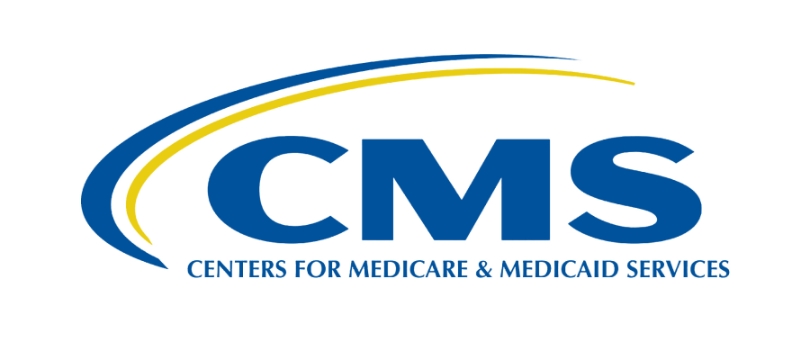
Chapter 2
Reputation Management = Quality Management
Without a doubt, this is one of the most important sections of this entire book. If you don’t have the time or energy to read every section, at least read this one.
Because it’s easy, because it should be second-nature for customer-facing workers.
It should be a priority for even those who work behind the scenes and never see customers. “It” is the Customer Experience (CX).

The Influence of CX in Other Industries
There is a reason why a regional grocery store, Publix, has been hailed as a Wal-Mart killer. Their focus remains, always, on service, and their customers can tell the difference. Despite that their prices are a little higher, their customers are loyal, and their profit margins continue to soar. Publix was also the undisputed champion of customer satisfaction among supermarkets, dominating the number one spot on the ACSI rankings for 20 years, until the inclusion of Trader Joe’s and Wegman’s finally unseated Publix in 2014 (though it beat them both again in 2017).
For another solid CX example, we’ll turn from supermarkets to the gaming industry. Valve, a games developer and publisher, launched their Steam games marketplace in September 2003. Over the next few years, Steam would come to dominate the PC gaming scene and then hold it tight for over a decade with little-to-no competition (and, even now, with actual competitors on the scene, Steam remains dominant). Despite this near monopoly, the Steam service and Valve’s head honcho, Gabe Newell, were adored by gamers. Nobody wanted a competitor to Steam because the service was too good. A customer in February 2015 posted about his experience online, and that only served to heighten the love for Steam and Newell even further, as Newell, himself, graciously responded to the customer’s request for help, stating that “[a]t the end of the day, everyone here at Valve is in support.” The interaction ended with Valve’s CEO stating that it was fine if other customers wanted to email him directly with their concerns – because the customer experience takes priority over everything else.
Applying These Lessons to Improve the Patient Experience
Customers like to be treated like people, rather than walking, talking piggy-banks; there’s no simpler way to break down why focusing on CX can be so beneficial to the bottom line of any business. And in no industry is this more true than in healthcare. In fact, Doctor.com ran a survey which revealed that 86% of patients see good CX as the most important factor in giving a five-star review (with the assumption that good quality care was received). In the same survey, 61% consider hassle-free appointment booking to be a major factor in giving perfect reviews, and 42% will actively choose providers who allow for online scheduling over those who lack the ability.

Convenience is an important aspect of CX – it helps patients feel as though their time is being given appropriate value. Another is empathy. Nobody wants to see a doctor who doesn’t care about how they feel. And this perception of the doctor is also influenced by the staff who surround the doctor. When it comes to the value of staff interactions with customers or patients, a Bain & Company analysis shows that ‘CX Promoters’ have a lifetime value (for the company) that is worth 600-1400% that of ‘CX Detractors’. This is due to a basic tenet of capitalism: if a customer doesn’t like one seller or provider, they’ll go to a competitor. It doesn’t matter whether the issue is the price or the experience because the end result is the same: you have one less returning customer.
So how does a medical practice ratchet up their empathy ‘score’? The real, long-term answer is going to involve a staff who genuinely cares for the patients (and management policies which don’t emphasize the things which lead to apathetic staff). But overhauling the office culture isn’t an overnight fix, and even if management knows that a change is needed, it’s much more difficult to figure out exactly what changes need to happen.
Luckily, there is a fast solution which also leads to the long-term, positive culture progression which a doctor’s office might need…
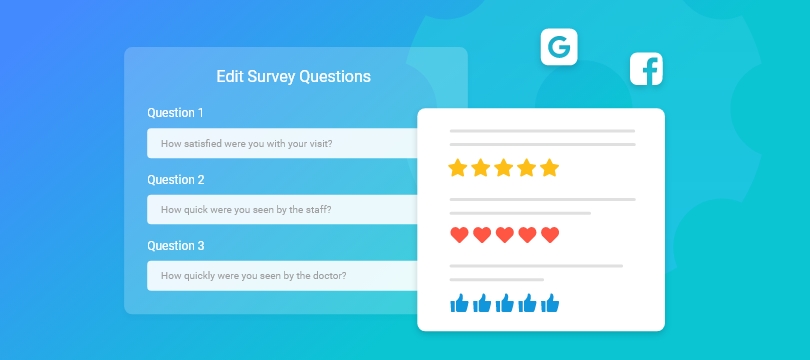
Ask the People Most Qualified to Judge the Measure of Your Patient Experience
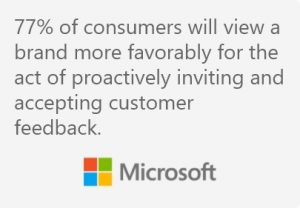 Asking for feedback is a fast and sure-fire way to heighten a patient’s perception of your practice. According to a report by Microsoft, 77% of consumers will view a brand more favorably for the act of proactively inviting and accepting customer feedback. So if you only set up a little station with pens, paper, and a shoebox, three out of four patients will likely think better of you for having some method of seeking information on what you’re doing wrong (or right) when your staff points it out. That last element is important: they can’t like you better if they don’t notice that you’re making an attempt.
Asking for feedback is a fast and sure-fire way to heighten a patient’s perception of your practice. According to a report by Microsoft, 77% of consumers will view a brand more favorably for the act of proactively inviting and accepting customer feedback. So if you only set up a little station with pens, paper, and a shoebox, three out of four patients will likely think better of you for having some method of seeking information on what you’re doing wrong (or right) when your staff points it out. That last element is important: they can’t like you better if they don’t notice that you’re making an attempt.
Seeking out this information gives you access to the information that you need to use to make informed decisions about where improvements need to be made.
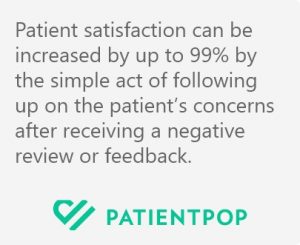 This opens the door to another easy way to increase patient experience and satisfaction. According to Joel Headley at PatientPop, patient satisfaction can be increased by up to 99% by the simple act of following up on the patient’s concerns after receiving a negative review or feedback. Showing that your doctors and staff care about the patient, showing empathy, can lead to serious spikes in your CX, which leads to much higher review scores.
This opens the door to another easy way to increase patient experience and satisfaction. According to Joel Headley at PatientPop, patient satisfaction can be increased by up to 99% by the simple act of following up on the patient’s concerns after receiving a negative review or feedback. Showing that your doctors and staff care about the patient, showing empathy, can lead to serious spikes in your CX, which leads to much higher review scores.
Making Change Work For You
Once you’ve begun inviting and receiving feedback, you’ll begin learning what would make your patients happier. That will be the most accurate and detailed guide you could go by. However, we’ve prepared a list of common improvements that can help make a practice feel more welcoming to patients. If you find that you’ve already implemented many or most of these, that just means you’re on the right track!
1 – Appearance
You know the old saying about how first impressions are important? You never get a chance to make a second one. Patients will be judging your facility from the moment they drive up. A neat, clean aesthetic look on the outside can bolster confidence that they’ve chosen a good practice; an inviting, open waiting room helps them to feel welcome and comfortable. There are a few things that you can do to maintain these aesthetic standards, and this article by Arminco Design covers all of the bases.

2 – Family Friendly
If you’re a pediatrician, you likely have this one covered. For other practices, parents usually try to make plans so that their children don’t have to come with them. Sometimes, though, it just isn’t possible.
This fact presents challenges. Most notably: children don’t sit still very well. If at all possible, it is best for everybody – the child, the parent, and the other patients – if the child can pass the time while playing somewhere off to the side. If possible, this should be a small, but open, room with a few toys, books, and a place for parents to sit and keep an eye their children while waiting. The room should be partially walled off to minimize the noise audible in the rest of the waiting room, but also allow for any waiting parents to hear their names being called.
An optimal solution may involve placing the playroom beyond the checkpoint where children can continue to play while parents are taken to an exam room.

3 – Online Accessibility and Functionality
Before patients ever come in, they will need to complete an interaction with your office in some way, shape, or form. Automating any of these possible interactions frees up your staff to better support the patients who are in the room or who actually need direct help with scheduling, etc.
The ability to schedule appointments online is an immensely popular feature already offered by many practices, and the sheer convenience factor will influence this. (This statistic bears repeating) 42% of patients actively look for and select a provider based upon whether online scheduling is an option.
Other accessibility options include implementation of online chats for general questions and a message system which could replace the nurse line for important medical questions (taking care, of course, to ensure that there is no breach of confidentiality or patient data security).
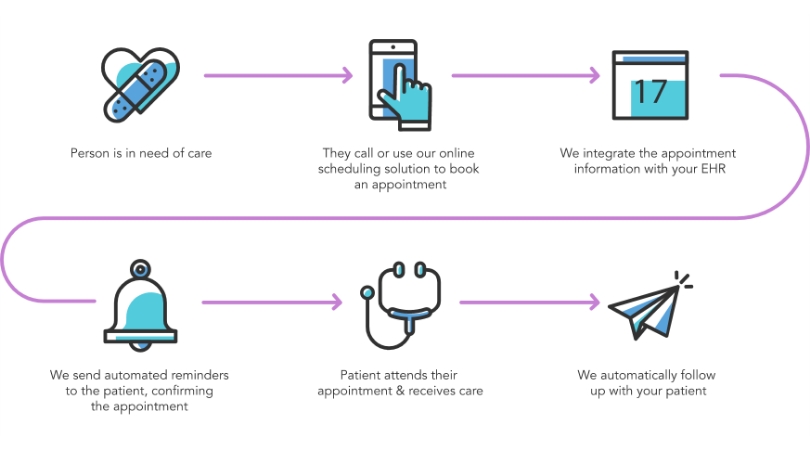
4 – Waiting Room Amenities
You want to keep your wait times as low as possible, of course. But bad days happen. Something goes wrong somewhere, and wait times are suddenly at an hour or more. But the wait times can be bearable (assuming that none of your patients have anywhere they have to be) if you have the right amenities.
First, freely accessible wifi should be standard in any waiting room. Bored patients quickly become impatient, but nearly everybody has pocket-sized computers they carry with them, and it’s exceedingly easy for most people to find something on their phone to amuse themselves with. Unless they’re having to conserve their battery. Which leads us to the next thing which should be heavily considered:
Charging stations.
There are two main cords used for charging phones (as of the time of this writing, those are Lightning and USB-C), and you can get a three-pack of ten-foot cables for less than $15 in both standards. Many retailers sell end-tables, coffee tables, couches, and other furniture items, which include USB ports for easy charging. Even without that, a single surge protector could hold at least six chargers. Relatively speaking, this could be a fairly cheap bonus to offer your patients.
Making practical use of the ubiquity of mobile phones, your staff could curate a shortlist of educational content relating to different medical conditions, diagnoses, or trivia. Tag these with QR Codes and post them up around the office for curious customers to investigate. When patients have concerns about being potentially diagnosed with specific conditions, the staff can help them to prepare for an appointment by pointing them to the appropriate QR code.
Lastly, make certain there are refreshments available. A water cooler or fountain is essential. You might also put out a table with individually-wrapped, healthy snacks. You could also choose to keep these at or behind the desk and only pull them out to offer during those long-wait instances if you want to save a little money.
Chapter 3
Utilizing Patient Satisfaction Surveys To Grow Your Healthcare Business

What’s the Best Review Management System For A Healthcare Business?
Healthcare is a highly variable and demanding, but vital, industry. It’s also the industry that sees its providers fighting for their own survival, financially and otherwise, on a daily basis. Review management isn’t usually the top priority for medical professionals fighting to save lives, or, at the very least, keeping people healthy and happy.
There are tons of reputation management systems out there to choose from which adds an extra layer of complexity. On top of that, switching from one system to another isn’t always simple. For these reasons providers or healthcare workers are encouraged to do thorough research and ask questions before deciding which review management system is best for their business.
Regardless of what system they use, doctors need reputation management
Progress is ceaseless. Restless. Nothing is ever the same for long, with possibly the sole exception of the nature of change, itself. People change, and society changes with them as technology develops and trends and philosophies come and go. Thus, in a capitalistic society, businesses, too, must change, evolve, and grow, or lose out on customers and profit as a result. Healthcare is no different, and the paradigms have recently undergone a major shift.
For most of the 20th Century, the most crucial factors for providers was location. As transportation technology improved, other factors such as bedside manner, word-of-mouth reviews, and newspaper coverage could all have a greater impact. Now, potential patients have options, and there are sources which make comparing those options easy. Patients have more power in selecting their health providers than ever, and providers who ignore the channels they frequent will lose out on valuable business.
Standard advertising is no longer sufficient because whether or not potential patients know of your practice’s existence does not sufficiently encourage them to come in, even if your location is convenient.
Physicians, practice managers, and marketers need to actively work toward getting more patient reviews as well as collecting more negative feedback.
The healthcare marketing landscape has changed irrevocably. However, with an effective marketing strategy and the right tools, it is possible to make these evolutions work in your favor. With an ideal reputation management service, whether it’s Medrev, ReviewTrackers, Reputation Loop, or something else, healthcare providers can take control of their online presence.
Patient satisfaction is crucial for medical providers. Happier patients mean better HCAHPS scores, fewer lawsuits; more funding, more grants, more opportunities to grow. The evidence of this general happiness, left online, will begin to draw more patients through to the business.
Healthcare providers have a monumentally important, and challenging occupation. Let’s make it a little easier.
If you need more insight or help to review your options, please, click the link below to contact us. Good luck, and thank you, to all of the doctors, nurses, EMTs, and support staff out there!
If you’re interested in seeing what a reputation management system, designed specifically for doctors, can do to help your business, then please, click here for more information.
The First Consideration in Choosing the Right Software for Your Practice
This item is first on the list for a reason:
Private Feedback Collection
Few review management services offer private feedback collection through satisfaction surveys. Yet this is one of the most powerful options available on the market today. Especially when it comes to healthcare businesses.
A satisfaction survey allows medical businesses to directly and reliably gather patient experience data straight from the source. Sure, you could pull info from online reviews, but why would you wait for a bunch of negative reviews to pile up? Reviewers will talk about whatever they feel like, whereas surveys allow you to seek feedback on specific aspects of your business – so you get responses on everything from everybody who fills it out.
A multi-step process can put any information received to use in the best way possible. Therefore, an ideal system will first collect private feedback from a satisfaction survey. If a patient’s feedback is positive, then a follow-up review request (with direct links to preferred review sites) is appropriate to send out – with zero actual pressure, of course.
If the feedback is negative, the best surveys will give the patient a chance to elaborate through private comments. When this information is sent back to the provider it can be flagged for analysis or staff response. This allows the provider an opportunity to attempt to remedy the individual incident through private communication, and turn the negative experience into actionable information which improves their services for future patients.
Why Is This The Most Important Feature To Look For?
Private feedback collection is the first step toward ensuring that your practice maintains high standards – and it helps to project a patient-first image which, naturally, patients tend to like. This makes them more likely to be forgiving of simple errors, and less likely to leave without giving you an opportunity to salvage the relationship. For more on this, refer back to the Reputation Management = Quality Management section above.
Private Feedback Collection Examples
When it comes to implementing a feedback collection strategy, there are a host of options – both low- and high-tech. We’ll break down a few examples for each delivery method, and the next section will talk more about the various methods you can use to request reviews – some of which will be very similar or the same.
Low-Tech, In-Office Feedback Collection
Not everything has to involve a screen. If your office needs a budget solution which can be implemented literally overnight, then this is where you start. It’s as simple as creating a simple form a word processor, printing some, and setting them next to a shoebox with a slit in the top. Sure, decorate the box. Maybe put a sign next to it and make certain reception points it out. Then check the box every day.
If you’re not getting enough feedback daily, you can move a step further and incentivize the feedback. For this, it’s probably best to keep the box at reception. Adjust the form to include a ticket which can be torn off — the form goes in the box, and the ticket gets handed to the receptionist, good for whatever you think is fitting (a good base bonus could be a $5 credit on the account; for $20-30 co-pays, this is a sizable percentage).
Reception can also notate the account with the date of the redemption in case you want to limit the number of times that patients can get this credit. Once per calendar year would be reasonable, since most patients only come in once or twice per year, anyhow.
The most important thing is to make certain that the feedback is anonymous. You can include a name field on the form if you like, but make certain the delivery method allows for anonymity if the customer wishes that – the form shouldn’t be handed to reception and read on the spot, for example.
High-Tech, In-Office
For more high-tech solutions, there are a few options – some cheaper than others. Exactly what might work best for your office will take a little bit of thought and research (so this won’t be nearly as easy or fast to set up as the low-tech options above, but could result in feedback that is much more accessible and easier to review).
The easiest option, and possibly the cheapest, would be a mounted tablet which is set up on a survey form, and cycles back to the beginning upon completion. This is fairly easy to do with Google Forms, which is free and fairly customizable. There are also specialty survey programs out there, such as SurveyMonkey, which might cost a bit more, but could be more flexible.
If you pursue these surveys, make certain to set as many questions as possible to “optional” – within reason. You’re more likely to get surveys completed if patients aren’t required to spend too much time working on them (and on that note, also have at least two tablets set up for this). Another thing to consider, in order to maximize your feedback: smart buttons. Setting up three or four of these programmable buttons next to the feedback area allows patients to give a simple rating feedback when they’re more pressed for time. Each button can be programmed to provide a specific response which is relayed to an app on a nearby device.
There are also services like Happy Or Not and ViewPoint which provide dedicated devices which do all of the above if you want to pay for a more cohesive feedback collection service.
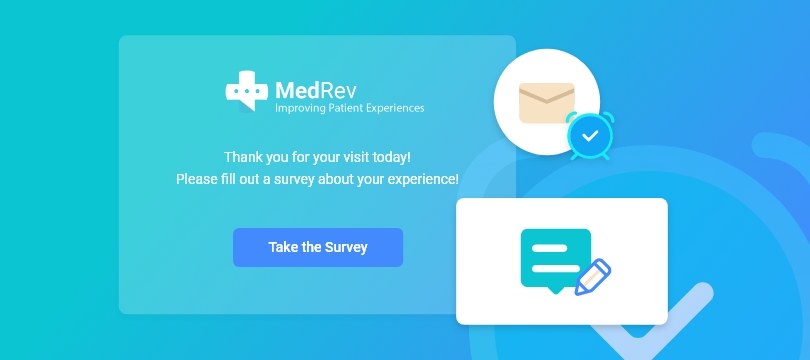
“Low”-Tech, Post-Visit Feedback collection
The most “analog” way to gather feedback after a patient has left the office after their appointment would be to mail them a questionnaire.
Yeah, I didn’t think that was a good idea, either.
So if you want to rely on collecting feedback AFTER the visit (because you probably don’t want to annoy your patients and artificially lower their impressions), then you’re going to need to rely on some sort of technology. There are two methods which, twenty years into the 21st Century, are effectively low-tech.
There are two potential implementations of this. The first is problematic and not recommended, but is being included here just in case you’re looking for a stop-gap measure (the shoe-box is still probably preferable). The major downsides are:
-
You will need to pay extra – either to have somebody make the calls or to have a service send out calls with IVR surveys
-
Either method will likely just annoy patients, as these calls never seem to come in at a convenient time
-
This data will be difficult to aggregate and analyze, at least with the manual calls
-
Manual calls, again, lack the inherent anonymity, which means you’re less likely to get completely honest feedback
The second implementation involves placing courtesy calls. This works best for patients who actually came in sick, rather than just for routine check-ups, because it typically begins with asking something like, “How are you feeling today? We wanted to take a moment to check up on you after your visit.” The call can then close with a request for feedback. But these calls still suffer from the last two bullet-points listed above.
If you’re going to go with something relatively simple and cheap, this is the way to go. You likely already collect patient emails, anyhow. Pair this with simple surveys on Google Forms or SurveyMonkey, and you’ve got easy and cheap surveys which do allow for anonymized feedback.
High-Tech, Post-Visit Solutions
“Solutions” is accurate, because this category of feedback collection methods will typically involve specialized services.
This is Medrev’s bread-and-butter. Studies show that SMS requests are more likely to receive responses – and faster – than standard email requests. These text message requests can route to a web-based feedback page (which looks nicer), or can rely on a series of SMS-based questions (which, for example, T-Mobile does every time you call their customer service line).
Either method works – it’s less intrusive than a phone call and feels more convenient than an email. But there are very few open-source solutions for this, which means you’re best-off going through a service which has specialized its resources for this.

Set Up Your Website For Any-Time Feedback
It is exceedingly hard, and getting harder every year, to get by without a website in today’s market – no matter which market you compete in. So odds are good that if you’re reading this and you own or operate any sort of business, you already have a website of some sort.
The good news is that there are numerous solutions available to help turn your website into a tool which can passively collect feedback for you. Options include pop-up surveys and well-placed “Feedback” buttons on the site.
Naturally, any feedback taken through this method should begin with a question asking whether and when the customer last had an appointment, or perhaps a selection of options for the user to choose from to give an idea as to what the feedback concerns. This will allow you to sort feedback into the appropriate piles, so that comments and suggestions for the website, itself, don’t get mixed in with anything service-based.
The Price of Healthcare Reputation Management Systems
When you’re looking at features and options one inevitable question will be about the cost. Different systems have different pricing models. Some charge a flat fee per business per month, while others charge based on the number of patients processed. Make sure you have a clear understanding of what your monthly bill is going to look like so there are no surprises.
It’s also worth noting that a low price tag could be a good thing in some cases, and a red flag in others. When looking at the cost of software systems it’s important to consider the features and functionality you are getting for the money you’re paying.
If your business has more than one location and/or multiple physicians you’ll want to keep that in mind as you compare different online reputation management systems.
Beyond price, you will need to think about how multiple locations and physicians are organized within the system. Are they all on one account or separate? Can you see data for all of your locations on one dashboard? The answers to these questions could mean the difference between a useful system and an expensive novelty.
Contracts & Terms
Many companies require a contract, making it even more important to make the right decision. Because once you have started with a company, many times you are locked in for months or even years at a time. Which of course may be a good or a bad thing depending on the situation. So, consider your needs and if a long term contract makes sense for your company.
On top of the length of the contract, always look carefully at the terms. What is the process for early termination? Is there a penalty? How about a trial period?
Contracts are long and not much fun for most of us, but it’s crucial to always read and understand your contract thoroughly. That goes for all contracts, not just software.
Terms of Service
Before you even get to the point of signing a contract, find the Terms of Service for the companies you’re considering. It should be listed in the footer on the site. For an example, here is Qualtrics’ Terms of Service.
This isn’t the actual contract, of course, but it does cover a lot of the expectations that the company expects their customers to abide by. It’s a good idea to read through this and get an idea of how this baseline agreement is structured and check it for fairness.
For example, their Force Majeure clause, section 12.9, states that should, say, a tornado strike their processing center and render Qualtrics incapable of providing service, then Qualtrics hasn’t broken the contract (because they can’t control the weather); but it also states, up front, that in the case of such events, Qualtrics will extend the ending date of the contract (because the customer doesn’t control the weather, either. It’s a forthright, fair policy.
Another, more specific thing to look up and consider within the Terms of Service is a section on the contract’s governing law. In this case, it’s section 12.10, and states that Qualtrics and its contracts will operate under the laws of the Commonwealth of Pennsylvania. If your company is also based in the US, then this is great! But if the company operates under foreign law, you’ll want to review whether the country in question has fair processes for resolving foreign disputes. Some, such as France, the UK, or Sweden should be perfectly fine. But there are some nations you may wish to avoid dealing with, or at least do more research on before taking the leap.
Contract Examples
We’ve managed to find some examples of contracts to give you an idea of what you can expect the terms to include. We encourage you to do more detailed research, especially about contracts specific to the service providers you’re considering most heavily.
-
-
This contract example shows that if you’re paying enough, Qualtrics (and possibly others) is willing to adjust their standard contract. However, one data point is insufficient at showing what price points grant you leverage enough to make alterations. Still, if you don’t like a clause, it doesn’t hurt to ask about making a change!
-
Healthcare Regulations Viability
The upside to a system built for the medical industry is that it is built just for businesses like yours instead of being adapted to meet the needs of restaurants, retail shops, hairdressers, and every other business type out there. For healthcare specific systems, the software should maximize usability and streamline data collection processes and provide professional reputation consultation from a team that is experienced in healthcare.
You must also consider that more generic systems may not adhere to all of the guidelines that healthcare practices are required to.
A Deal-Breaker Exists
The most important requirement, whether you’re using a generic system, or an industry-specific one is HIPAA compliance. Most systems will tell you they are fully compliant, but it’s always a good idea to check it out for yourself to make that determination instead of taking their word for it.
If pulling the trigger means signing a contract or dedicating a certain amount of time or money to this system, don’t do it without consulting your legal team for confirmation that you’ll remain within compliance, as that could cost you more down the road.
Support & Training
This is one of those things most people do not think about until they need it. But by that point, you get whatever is available.
When comparing healthcare review management systems, support, training, and education are not to be overlooked. Proper support can make a big difference, especially to teams that do not have a lot of experience with digital marketing.
When you need help, do you have a specific representative to call or do you have to send an email to the support team and wait for a reply? Will the support person get on a video call with you and walk you through any issues or will you be directed to an article? Is there a limit to how much support time you get each month?
You will inevitably have questions and, when you do, you don’t want to jump through hoops to get them answered.
On top of support, what training is available when you’re getting started and what does it cover? Is it a live team meeting or a recorded lesson? Can you pick and choose what to go over? What about ongoing training?
Without proper support and training, you might end up missing out on features and ideas that could be a big benefit to your business. As the saying goes, you don’t know what you’re missing.
Methods of Review Requests
How patients are contacted can be just as important as what the message includes.

Most providers keep contact numbers and email addresses on hand for patients. Using either or both for contacting patients are tried-and-true methods for requesting online reviews and gathering data on customer satisfaction.
However, email isn’t something that comes across as ‘urgent’ for most people, and a phone call survey is often viewed as an annoyance or an intrusion.
A research article published by Pew shows that patient satisfaction surveys can be completed faster, and slightly more often if a combination of SMS text messages and email invitations are used.
The most effective systems utilize both text and email in a smooth and non-intrusive sequence. For example, some systems start with a text message after a patient’s appointment which includes an invitation to a satisfaction survey, and then, based on the survey response, send an email follow-up for an online review request.
Asking For Feedback
Once you’ve figured everything out, you still have to actually create the survey. We’ve compiled a guide here to help you understand what you should ask and, more importantly, how you should ask it.
Convenience is Key
Before anything else, you have to convince your patients to take the survey. The easiest way to do so, if you aren’t offering some sort of compensation, is to present the survey or questionnaire as a minimal interruption to their schedule. They’re already taking time away from work, family, hobbies, etc, to attend their appointment, so asking for more time, especially if they’ve already had to wait longer than expected, isn’t an easy sell.
Because of this, presenting the survey as a minimal interruption is crucial to ensuring that you get as many responses as possible. Of course there will be plenty of patients who don’t mind spending an extra moment or two giving you a response, regardless of anything else. But just like any other survey or scientific review, more data points are always going to help paint a more complete picture.
Composing Your Hook
Whether the hook is included in an email or on a sign posted next to a shoebox and stack of papers, you have to entice patients to respond. There are a few things to keep in mind for creating an effective hook:
-
The first line of the body should state, clearly, an honest time estimate for the length of the survey. This goes back to the convenience factor discussed above.
-
The survey should be designed so that at least 90% of respondents should be able to complete it within 5 minutes; the only exceptions should be those who want to be extremely long-winded in their responses.
-
-
If you have any sort of promotion or incentive involved with giving feedback, it needs to be mentioned in the subject/header, and again in the body with a little more elaboration.
-
Strike a professional, polite tone. Some businesses can get away with more humorous or mocking tones, but due to the nature of healthcare, a clean, polite tone is going to be your best option.
-
Make certain to thank your patients. This goes with the the ‘polite’ tone, but deserves to be underscored.
-
Utilizing Incentives

Incentives don’t have to be big. We touched on this briefly in the Private Feedback Collection Examples section earlier. A suggestion there was simply to offer $5-10 off of patients’ co-pays. It’s a minimal investment for the practice, but can at least put a sizable dent into the cost of lunch when your patient leaves to drive back to work. And, again, for most standard co-pays, just $5-10 is a decent percentage.
Another idea is to take names for a monthly or weekly drawing – everybody who completed a survey in the allotted time period is entered in a drawing for, say, a $100 Visa Gift Card. That is a much larger potential gain for patients for an amount of time that suddenly seems insignificant. Some will still say, “Oh, I wouldn’t win, anyhow.” Most, however, will employ the tried-and-true lottery justification: “You can’t win if you don’t play.”
Don’t Disregard Anonymity
The biggest problem with using incentives to drive feedback is that you now have to do something more to maintain patients’ anonymity. Many patients place a lot of value in their healthcare experiences remaining private; and the majority of survey takers prefer that their answers be anonymous, lest somebody get angry about the feedback they need to share.
But you can’t follow through with promised incentives if you don’t know who met the requirements.
There are a few potential solutions.
In-office solutions are simple – take a stub from the survey sheet to reception, or show the receptionist the “Thank you for your feedback” page on the tablet. All the receptionist knows is that a survey was completed.
For other delivery methods, such as email, you’ll want to start by seeing whether the software which you’re utilizing can save different sets of data within the same survey to different results files. If this isn’t possible, you can include directions for submitting their name and number on the completion page.
And if that isn’t an option, then your last potential measure is to pass the duty to a member of staff. Somebody was always going to need to receive and prepare the feedback, anyhow, to make it easy to see answers side-by-side, and redact any identifiers in freeform answers. If necessary, that person can separate identifying information for the purposes of honoring incentives.
Putting It All Together
Below is an example ask, appropriate for use in an email invitation or for posting beside an in-office feedback station:
Tell us about your experience for a chance to win a $100 Visa gift card!
Our quick, anonymous 3-5 minute feedback survey is an important tool for us to know how we’re doing. Your experience matters to us. Please provide your name and phone number at the end of the survey for entry into our monthly drawing for a $100 Visa gift card. Thank you for your time!
Creating Your Survey
A feedback survey needs to strike a balance:
-
It should be short, sweet, and easy to complete
-
It should return as much information as possible (otherwise, what’s the point?)
There are a few simple guidelines to keep in mind as you’re preparing your survey to help you find this balance.
Utilize Easy-Response Formats
Easy-Response formats are something that most people are familiar with nowadays. These are the groups of questions where you’re told to assign a value to each of a series of items, such as a 1-5 rank metric or an agreement metric ranging from “strongly agree” to “strongly disagree”. These formats allow for multiple things to be asked within a smaller space on the page, and with minimal time and effort required for the respondent to read and understand each question.

These formats should drive at least half of your questionnaire. They will give you the most information without unduly driving up the time it takes for patients to respond.
Other Questions Need To Be Simple
Again, we’re going for ease and efficiency, so the bulk of your other questions need to be phrased to allow for yes/no/other answers as much as possible. That does not mean that each needs to be a yes/no question, of course, but they should all be simple, straightforward multiple-choice style questions.
For example, you will likely want to ask each respondent when their appointment time was so that you can attempt to pin down if there are any times when service dips. For this, of course, you would break the answers up into ~2-hour blocks for early morning, late morning, lunch, etc. The same approach can apply if you wish to quantify wait times – which is something that you should do if your in-office software doesn’t keep track of those numbers for you. Asking patients wouldn’t be as accurate, but it could still be handy to have those numbers immediately available to cross-reference with the rest of the patient’s feedback.
Use Free Response Questions Sparingly
Optimally, there will be only one direct prompt for patients to type out a free-form answer, and it should be the final question asked in the survey: “Do you have any other comments or concerns you would like to share?”
That’s because these responses are the ones that will eat up time. Especially if:
-
Your practice has an older patient base
-
The survey is being completed on a mobile or tablet device with no proper keyboard
Further, all free response questions need to be optional. If they don’t want to write anything out, you can’t force them. Trying to do so will only frustrate your respondents, and they may abandon the survey without submitting it.
Aside from the final question, the only other time you should typically offer a free response question is as a follow-up. There are some questions where, if it’s a yes/no, and the patient answers “no”, or perhaps “other” if a third option is provided, you may want additional information. The only way to get that info would be to allow the patient some room to provide it. An optional question asking, “If no, why?” would fit, for instance.
Exceptions to this would involve times when you need specific information about specific elements of your practice. For instance, if you’re beginning to plan for a remodel of the waiting rooms (or the entire building), you might add in a question asking patients “What do you like or dislike about our waiting room? What’s missing?” This feedback could then be referenced when finalizing those plans.
Nailing Down What You Need To Know
So you have a limited amount of space and time to ask what you need to ask…
So what do you need to ask?
Well, there are a lot of things you need information on, and we’ve got a list (of course). Please note that this list is general, and does not include things that may be important for your practice (for instance, asking if a patient was greeted properly if you ask your receptionists to do anything specific) or your area (in case there are any state or municipal laws that have specific requirements which might be relevant).
-
Baseline/Corroborating Questions
-
Time of appointment
-
Approximate is fine if you want to make it a multiple choice answer; this would also give patients an extra privacy buffer
-
-
Date of appointment
-
-
Demographics
-
Age
-
Is the appointment for a check-up or for sickness
-
-
Waiting Room appearance/cleanliness
-
Wait times
-
Reception interactions
-
Back-office interactions
-
Bedside manner
-
Appointment booking satisfaction
-
Policies (in case there are any that patients have had specific issues with)
-
Bathroom appearance/cleanliness
There are more things you can consider and ideas you can steal from what other companies are doing. Below is a list of articles that you can check out for more information and some examples of feedback surveys that are being used by companies in a variety of sectors.
Chapter 4
Utilizing Patient Satisfaction Surveys To Grow Your Healthcare Business
 Most healthcare companies view online reviews as a topic worthy of at least a little attention, but how much effort should you put into increasing your number of patient reviews?
Most healthcare companies view online reviews as a topic worthy of at least a little attention, but how much effort should you put into increasing your number of patient reviews?
To answer this question we need to know how many people are looking at these reviews to determine their impact.
This trend isn’t exclusive to younger generations either. When adults of all ages are taking into account, we still see almost 9 out of 10 Americans are looking at online reviews.
 What this means for today’s healthcare marketing landscape is that good reviews are essential. It isn’t just a trend anymore – it’s a fact that medical practices need to come to terms with if they’re going to succeed:
What this means for today’s healthcare marketing landscape is that good reviews are essential. It isn’t just a trend anymore – it’s a fact that medical practices need to come to terms with if they’re going to succeed:
Having no control over your organization’s online presence means having no control over the flow of new patients into the waiting room.
Regardless of how long you’ve been administering quality healthcare to your community, your online reviews are what your patients, referring physicians, and potential job applicants use to judge the quality of your services and form opinions about your business as a whole.
How much do online reviews really matter?
In a nutshell, reviews are one of the most important things, arguably the most important, when it comes to boosting the popularity of a business.
Let’s take a look at the phenomenon known as ‘The Shed at Dulwich’. As the linked Washington Post article explains, The Shed at Dulwich was a “unique” restaurant in London and certainly the hardest to get into with a one-year waiting list. To be fair, that’s mostly because no one got in because it was literally a tool shed in a guy’s backyard.
 Although this quirky “restaurant” had never served a single meal and included pictures of their “farm-to-table dishes” which were actually carefully angled photos of a foot and some toilet bowl cleaning tablets, it made its way to becoming the number one restaurant in all of London on the popular review site TripAdvisor.
Although this quirky “restaurant” had never served a single meal and included pictures of their “farm-to-table dishes” which were actually carefully angled photos of a foot and some toilet bowl cleaning tablets, it made its way to becoming the number one restaurant in all of London on the popular review site TripAdvisor.
The fiasco didn’t last long before the mind behind this social experiment admitted it was entirely made up, and the reviews were totally fabricated. There is a lot that can be unpacked from this little scheme that The Shed at Dulwich’s creator ran, but the most important thing for this discussion is to just note that this restaurant, which didn’t even exist, had the phones ringing off the hook with people begging for reservations simply because of the online reviews.
In the end, reviews aren’t the only thing that matter, but they clearly count for quite a lot.
Welcome To The Google Age.
The internet is a source of information unlike any other. Whatever you could hope to learn can be found on a server somewhere in the world. Or several. This includes details regarding your business. And these details are visible to an ever-growing audience. Even back in 2013 there was a quickly growing number of people looking for health information online. Please note that these numbers are, at the time of this writing, over five years old. So, let’s talk about the difference between then and now.
How quickly is the importance of online reviews growing?
 When we compare this data from a few years ago to today’s numbers it becomes incredibly clear that online reviews are increasing in importance.
When we compare this data from a few years ago to today’s numbers it becomes incredibly clear that online reviews are increasing in importance.
In 2013: 34% of adults looked at online reviews of health providers.
Today: 81% of patients identified reviews as critically important for them to research before choosing where to go for medical care.
That’s more than a two-fold increase of people turning to online reviews to evaluate healthcare providers in just five years!
Alright, your online reputation is obviously important, so let’s take a closer look.
Are unhappy patients really the most likely to leave reviews?
It’s up for debate. An odd psychological quirk makes negative reviews harder to avoid. According to the linked article by the AAAHC (Accreditory Association for Ambulatory Health Care), unhappy patients are typically more likely to spread their experiences than happy ones.

They say that satisfied patients will share their positive experience with five others, on average, and dissatisfied patients complain to nine (or more) other people.
In other words, an unhappy patient is more motivated to spread their (unfavorable) opinions than a happy one. One unhappy patient is enough to undo the good word spread by two happy patients. AAAHC’s article raises several other good points about why it’s vital to ensure that every interaction is positive.
But is it really true that most online reviews are negative? Other sources say no, it’s generally the opposite. According to a study published in the Journal of General Internal Medicine (JGIM) in 2012, the four authors found that the truth was a little more complicated.
The authors, using yelp.com and ratemds.com as their primary sources, note that due to the unfiltered, public nature of online reviews, many physicians perceive a danger to their professional reputations.
However, they go on to state that their findings suggest that most internet reviews convey positive sentiments about primary care physicians.
There Is Power (And Positivity!) In Numbers
Not only do they state that “most” reviews were positive, but they found a trend in their research, as well. Most doctors appearing at the beginning of an online search had a higher number of reviews and a higher overall rating score, while doctors appearing at the end of a search had fewer reviews and/or a lower overall rating score.
Gathering more reviews is, in the end, more conducive to establishing a positive online presence, better online rank, improved SEO, less expensive PPC advertising, and greater overall website traffic. And those are all just side effects of increased trust that a good reputation provides. It’s not hard to see why you have to know what your patients are saying about you. Ultimately, this means that it’s important to focus on getting more patient reviews, and not just trying to control your rating.
Three Keys to Patient Satisfaction
Satisfied patients are the lifeline of a medical practice, but unhappy patients can cause a business to collapse. Good or bad, we want to stress just how vital it is to not only gather the feedback but to understand why and how it came to be. To dissect the motivation behind reviews we need to take a closer look at what specific factors reviewers mention in their feedback.
The study on NCBI pinpointed the most common comments for both positive and negative patient reviews.

What Do Patients Mention Most In Positive Reviews?
The study found five main topics of positive reviews to be:
- Trust and confidence in a doctor
- Ease of appointment making
- Good interpersonal relationship
- Perception of the doctor as empathetic and friendly
- The doctor’s communication skills
These five topics can be further condensed into three key elements: Communication, Convenience, and Relationships.
It’s worth noting that though patients may initially select a doctor in part based on his or her specific qualifications, such as the prestige of their medical school or post-graduate training, this does not seem to be a common talking point in patient reviews.
What Topics Are Patients Most Likely To Talk About In Negative Reviews?
The breakdown of the study’s findings then begins to delve into the recurring themes for dissatisfied patients which are:
- Poor bedside manner
- Perceiving a physician as antagonistic
- Dissatisfaction with wait time
- Difficulty making appointments
They also take the time to clarify, for definitive purposes, that patient dissatisfaction appears to be more than the absence of satisfaction.
Going further, if you look at these four ‘themes’ more closely, they can, once again, be reduced to the three keys mentioned earlier, except inverted. This time, it’s poor communication, a lack of convenience, or a seemingly antagonistic relationship which is the cause for a bad review.
What Kind Of Reviews Do Neutral Patient Experiences Lead To?
This last bit makes clear that patients do have a measure of patience, and understand that not everything can be perfect. Therefore, neutral interactions will not typically trigger negative reviews.
All of this, together, implies that not only would you have to trigger a negative reaction somewhat actively, but that there is a somewhat disproportionate distribution of factors which determine a patient’s final opinion of their visit as they walk out of the door. This disproportion is weighted toward interpersonal interactions.
Increasing Patient Focus
This study suggests that healthcare businesses should increase efforts to make the office environment more patient-centered. Ultimately, of course, the doctor should also be knowledgeable, as a misdiagnosis would override all of the weighty gloss. Nevertheless, patients are more likely to see their visit as favorable if the entire staff is equipped with good, basic customer service skills.
If your staff, top-to-bottom, is trained to focus on basic customer service skills, emphasizing these three key elements of Communication, Convenience, and Relationships, then the vast majority of reviews will organically shift to be positive and enthusiastic.
Which Patients Are Writing Reviews?
There is one final takeaway from this NCBI study which may be helpful for medical practitioners who are trying to step up their online presence: demographics.
The study states repeatedly that demographic information is very limited and that patient review sites differ significantly from the traditional patient satisfaction surveys with which health systems and researchers typically assess patient satisfaction.
In short, they don’t know terribly much about who, exactly, tends to fill out these reviews. This is partially due to the fact that one of their two source sites, RateMDs.com, does not collect demographic information about their website’s online reviewers.
However, due to a few factors, such as general demographics, demographics available from Yelp.com, and the geographical limitations of the study, a few core details can be found.
Patients completing Internet reviews are younger and more affluent.
Yelp’s demographics show that their reviewers trend toward younger adults and those with college degrees, as well as a disproportionate number of reviewers who make at least six figures. However, this study was published in June 2012, so these figures may no longer be as accurate as they were.
The main takeaway from this study is that, generally, more reviews overall seem to yield better results. This is especially true if your campaign to drive online reviews catches happy patients who normally wouldn’t think about going online to review your practice.
How Many Reviews Do You Need?
We’ve covered that quality is important, and that it’s actually fairly easy to achieve with common-sense customer service strategies. And we’ve discussed which patients tend to write reviews. But how many of them do you actually need to stand out? Well, let’s start at the same place everybody does: zero.
How often do patients choose a doctor without any online reviews?
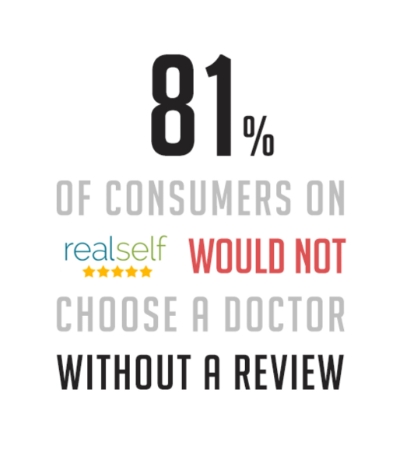 To take a close look at how healthcare companies can improve their online reputation, RealSelf has compiled a short list of tips to help medical practices get more patient reviews.
To take a close look at how healthcare companies can improve their online reputation, RealSelf has compiled a short list of tips to help medical practices get more patient reviews.
The numbers and tips in this article are current, as of the time of this writing. So, let’s see how much the number of reviews matters to patients.
Failure to foster a significant online presence could mean having your pool of potential patients – and revenue – cut by over eighty percent.
Medical practices with no reviews at all are not able to gain trust with the general public.
This is especially true with sizable organizations since consumers expect more reviews from larger or more established businesses.
- New
- Small
- Dated
- Non-existent
- Bad at what you do
It might seem like a stretch, but it’s true, especially if you have no reviews on Google.
If you are still waiting for your first online review you don’t have to sit idly by. Taking a few proactive steps can help you get patient reviews and gain trust from your community.
Reading online reviews is crucial for most patients and more reviews means greater trust
The tips provided by RealSelf are straightforward and simple to implement – and mostly involve good soft-skills like a positive atmosphere, friendly staff, and good bedside manners. Placing emphasis on these skills will ensure that most patients leave happy.
But you still need them to post positive reviews. And even practices with an average rating can be more trusted online than one with over 4.5 stars if the latter only has three or four reviews. So while quality is definitely an issue for every provider, you need to begin working on your procedures for bringing in more reviews immediately.
Increasing Your Review Count
We’ve already covered a few tips for increasing the amount of feedback you get from your patients, but what about reviews? Well, the processes aren’t so very different. In fact, when you’re ready to begin pushing for reviews, it’s fairly simple to work it into your process for asking for feedback.
A Few Quick Tips To Get More Patient Reviews
There are many ways to ask your patients to leave a review on your desired site. First, of course, you’ll need to decide what your online approach is and where you want to focus your online presence (keep reading for our breakdown of which sites are going to be your best options, but we also recommend asking patients what platforms they use online for reviews, and this may aid your decision). Once you have that, you’ll need to implement some changes in how your front-of-house welcomes patients. Here are four easy-to-implement tips for encouraging patients to follow through with reviewing your practice:
1 – Ask for a favor, not a review. Asking for a favor often more positive and empowering. Empower your patients, and they’ll often use that power for good.
3 – Establish a deadline. A soft deadline reminder can help to reinforce the reminder, just by the receptionist saying, “Great! I’ll look for your review in a couple of days.”
4 – Make it easy. The biggest thing you can do to improve your chances of patients giving you online reviews is not only to ask but to make it convenient for them. If all they have to do is click on a link in an email or text message, you take away a lot of the effort required on the patient’s side.
There are also other methods that can be used, such as phone calls, text messages, and links on your website. There are a lot of different approaches to increasing online ratings. And you don’t have to pick just one. Try a few and see what works for your business.
Getting more reviews supplements your online presence
With some simple strategies, you can quickly get more patient reviews. But remember that an increased number of patient reviews is not the only thing you should be striving for. This is just a small part of the bigger picture, your online presence.
Many medical businesses have an employee who is tasked with building and maintaining the company’s online presence. Others enlist the help of a third party digital marketing company, and some choose to use a variety of software systems that do the brunt of the work.
-
Responding to communication on social media accounts
-
Maintaining up to date information on all platforms and websites
-
Writing and posting blog articles
-
SEO (Search Engine Optimization) research and implementation including keyword research
-
Online review management including reading and responding to reviews across platforms
-
Paid advertisement management
-
Website testing and maintenance
-
Ongoing competition analysis
-
Social media posting
-
Email marketing list management and outreach
-
Networking with referring partners on social media like Linkedin
-
Job postings and outreach to potential new hires
That’s just the basics, and clearly a lot of work. It’s easy to see how many healthcare businesses fall behind.
Beware the ‘Quick Fix’ Pitfall
There are reputation management services which advertise making alterations to negative reviews or even deleting them. There are review management companies that promise to get you 100 5-star reviews overnight. These might sound like the golden ticket, especially to practices who are seeing just how badly a low online rating can impact their revenue.
You might see a competitor’s ratings skyrocket and panic. How can you compete with 639 positive reviews? But BEWARE!: If you come across a system seems too good to be true, it probably is.
Review sites – all of them – have clear terms and conditions for their use. They also have large numbers of employees dedicated to enforcing those contracts, and they’re cracking down. Not only because nobody wants this to be put into the ‘fake news’ category, but because it is bad for their business models to allow this to continue.
Then, there is the question of legality.
Actually, er, no. Sorry. There’s no question. It’s not legal.
Getting caught dealing in or with fake reviews could net you fines, deletion of your account(s), or possibly a mix of these things. Google, reportedly, hasn’t actually taken much real action just yet, but that doesn’t mean it’s a good idea to push your luck. I mean, with how much data Google has on you (and all of us), you won’t be ready for their retribution if and when it comes.
So, not only is this sort of action unethical, but it’s just a bad idea all around.

A few honest negative reviews will not hurt a business’s reputation nearly as much as the inevitable breaking of the story about their dishonesty. Plus, let me emphasize, there could be big fines and legal action on top of that. Healthcare providers have enough lawsuit worries to deal with and it goes without saying that no provider wants to actually see how well their legal budget compares to Google’s.
A reputable online review management service will not promise to prevent, delete, or alter any negative reviews.
Anyone looking to grow their business by boosting reviews will need to consider their options carefully to choose the best service to get them to where they want to be.
Don’t Discount Social Media
How to improve your online presence through social media management
More reviews are the first step, but it’s important not forget this is just one part of your online presence.
Reviews are closely linked to social media, especially Facebook. However other social media platforms such as Linkedin, Twitter, Google+, as well as a long list of social media sites specifically for physicians.
A video from Akron Children’s Hospital in Ohio details the facts about online presence and hospitals. It points out some hard-hitting statistics about online patient engagement and healthcare. Here are a couple of the most impactful:
-
81% of consumers believe that if a hospital has a strong social media presence, they’re more likely to be cutting edge.
-
72% of consumers would like assistance in scheduling doctor appointments through social media…and nearly half of those said they would expect a response within a few hours.

Now, this may be slightly different for smaller practices, however, an active social media presence can still help strengthen potential patients’ impressions of a practice regardless of the size. Social media, especially Facebook, is an important tool to draw patients toward your business instead of a rival’s.
The Importance Of Social Media In Healthcare Is Growing Quickly.
The most shocking thing about these numbers, if you’ll recall what we’ve already discussed in regards to the direction they were trending: Akron Children’s Hospital published that video in 2012. Which means that the importance of social media is greater now than it was at the time this video was made.
And, barring global catastrophe (which would make this discussion moot), these numbers will never again be so low as they were in 2012. Reliance on electronic communication and informational services is the new “normal”. A well-designed webpage is today’s clean and inviting storefront. Likewise, a high review count with a good average rating is the new word-of-mouth. And, as has been covered earlier, both the rating and the number of reviews are important.
If Your Hospital Or Practice Hasn’t Yet Caught On, You Aren’t Alone
As of 2014, only 26% of Hospitals were using social media to bolster their online presence. This number, while slightly outdated, is important for several reasons. The healthcare industry is slow to adapt to new marketing techniques, and this may relate to the nature of the industry (modern healthcare is rooted in science, and science is rooted in evidence, first and foremost; healthcare decisions should never be based on trends). There are a few other reasons why the leaders, decision-makers, or executives of various healthcare providers may be slow to jump on the social media train:
1 – Social media carries connotations of entertainment or, say, teenage drama. Since it’s used for everything from cat photos to political posts, it isn’t always seen as ‘professional’.
2 – They fail to see the value that a social media presence could provide for the organization or community, potentially because of the connotation mentioned above.
3 – There is also the fear of “rocking the boat.” If business is going well, then why change anything?
4 – They do not know how to build a social media strategy that will benefit their business and their community, or that would be effective in the community that they serve.
5 – Many healthcare businesses do not have a staff member trained and designated as a social media manager, or that any social media specialist they have hired is being stifled by management who falls victim to one of the above.
The Social Media “Trend” Died Years Ago
If your healthcare organization has yet to establish itself online through social media, that should be one of your first steps. After all, social media became the preferred method for interacting with a company, any company, by 2016.
Here’s How To Get Started Or Grow Your Social Media Marketing
1 – Use legitimate, professional photos. These will cost more up front but will result in a more professional presence. Stock photos may look nice, but they are very…obvious. They have the effect of distancing you from your audience (which is problematic, because a successful strategy – especially for medical practices – will often utilize the concept of community as a foundational element).
2 – Build and enforce guidelines for your team. These guidelines should be aimed at maximizing patient privacy, protecting confidentiality, and maintaining HIPAA compliance. These guidelines will allow your social media team to know the boundaries and keep your practice’s reputation in good standing. However, remember that questions sometimes arise. For this reason, ensure that the leader of this team has direct lines to any legal or compliance specialists to ensure quick answers and turnarounds when any problems occur.
3 – Keep your reviews front-and-center. This should be a central element of your presence, for reasons outlined throughout the rest of this article.
4 – Organize a campaign. Use your knowledge of trending social issues of the community (locally or nationally), or what your hospital or practice specializes in. Work with your team to come up with ideas that you can use to brand your online presence. Find a cause and pursue it. The team over at Stratasan has compiled some great examples of this on their blog. These examples of hospitals that have grown through social media can help bring a new perspective to any medical business and their marketing ideas.
This is often most effective when it is aimed at education or outreach. Hospitals and other medical practices are full of knowledge. Utilize that to better help the patients you serve.
5 – Keep your focus local. Most people don’t travel very far for routine medical appointments. If your practice is affiliated with a hospital, then ‘local’ could mean something a little different for you, depending on the particulars. Either way, utilize the information you have.
If you decide to make use of paid ads through social media, you can limit the geographical area that your ads will appear in. Use your patient registry and focus in on the zip codes that most of your existing patients live in. You can also take note of the neighborhoods, apartment complexes, schools, churches, etc, that fall within these areas to create any number of community-focused marketing campaigns.
 PROTIP:
PROTIP:
No matter which social media sites you choose to utilize, there are a few elements you need to keep posted in prominent, easy-to-find spots:
-
Your practice’s address
-
A link to your website
-
Hours of Operation (this is a critical element – keep it updated!)
-
A picture of your location on the profile
Chapter 5
The Psychology of Online Reviews
Why are reviews so important? How does that psychology work? Does it really help to ask your patients for a review?
Let’s Start With Analyzing Review Accuracy And Quality.
The quantity of reviews is a guarantee of accuracy. Just as a small sample size in any peer-reviewed study will cause serious questions about methodology and validity, consumers who find only a small handful of reviews on a product will suspect somebody is trying to fool them. Especially if the comments are all praise, yet lack any meaningful details.
Often, in these cases, somebody with a vested interest in a product or service has reviewed it to try to increase its ranking and encourage people to buy. Thus, more reviews in total, even with some bad ones, is a reassurance of actual quality. Potential patients are more likely to look more seriously into choosing your practice with this sort of reassurance.
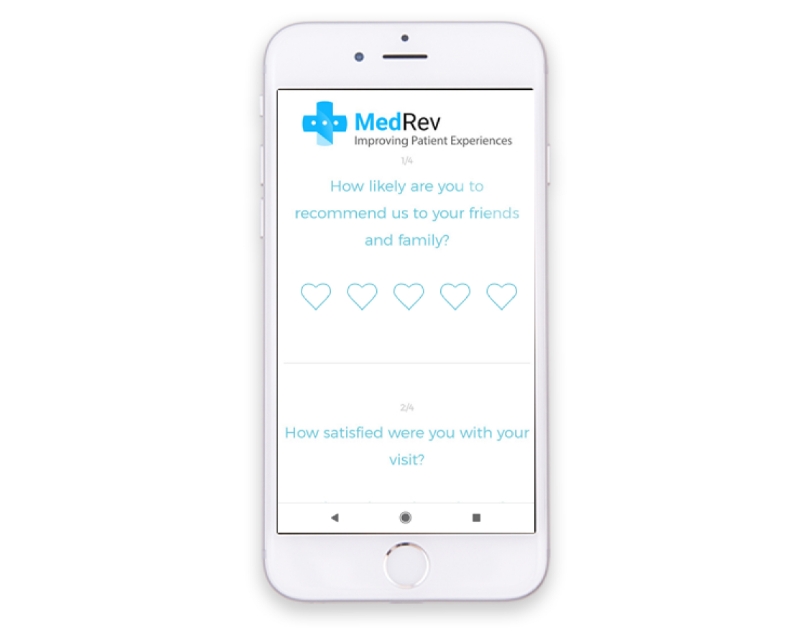
Could A Few Negative Reviews Actually Be A Good Thing?
Average consumers are increasingly aware that fake positive reviews do exist. What’s more, people are skeptical about the authenticity of a company when they have nothing but shining 5-star reviews. We all know you can please most people some of the time, or some people most of the time. But it’s just not possible to please everyone all the time.
This is why removing legitimate bad reviews can be one of the worst things you could do in trying to maintain your online reputation.
People expect that there will be a few unhappy customers every now and again. They know your team is made of human beings just like them and no one is perfect. The things that matter most here are:
1. What the patient writes in their review comment.
2. How you reply to the review.
This doesn’t mean that the quality of individual reviews should be ignored. But you can let a few 3-star reviews slide – everybody always expects a few – as long as the average is rather high. But I’m certain that you don’t need to be told that negative patient reviews can be a major repellent for patients. In fact, negative reviews can breed more negative reviews, which is why it’s important to take all negative patient feedback seriously.
Confirmation Bias Can Alter Patient Perceptions
This can occur when a patient either already has an appointment set or, due to circumstances (such as limited in-network options), the patient comes into the office after having read one or more negative reviews. The patient will internalize the negative remarks and employ confirmation bias, wittingly or not, to a visit that would normally be unremarkable – or even good.
If the patient noticed complaints about wait time, then anything over ten minutes will get them thinking “I knew it”. If the complaints were about rude staff, then even the slightest slip-up by any of the receptionists or nurses will be mentally stored for later. Maybe poor bedside manner is noted, and any indication that the doctor is rushed or tired or stressed will confirm it for the patient.
These are all things that patients might otherwise be understanding with. But as soon as they’re told that these are bad things to expect at this particular practice, then they’ll expect these bad things, regardless of actual service provided. Confirmation bias is a deeply ingrained aspect of human nature and most of the time people don’t choose to let information alter their perceptions. In most cases, we don’t even realize it’s happening. A quick Google search can provide plenty of evidence of its oft-lamented effects on every aspect of society.
The good news is that confirmation bias works both ways. If someone reads positive reviews before their visit, they are more likely to see the silver lining when things are less than perfect. Overall, the nature of your reviews sets the stage for the nature of an in-person encounter, good or bad.
The Effects of Physician Reputation in Children’s Healthcare
But the problem, especially for medical practices, is the evidence of how negative patient reviews can exacerbate small issues. The link provided here details a research study carried out and authored by a primary care pediatrician at the University of Michigan’s C.S. Mott Children’s Hospital.
Naturally, the study focuses on pediatrics, rather than general medicine. While, certainly, the argument can be made that parents are more careful (and even, perhaps, obsessive) with their child’s health than with their own, the numbers are still going to be remarkably dire even if we allow an optimistic ten-percent error margin. The study provided parents with three scenarios:
1. In the first scenario, parents “were told a doctor who took their health insurance was recommended by a neighbor.” With this prompt, only 22% of parents polled replied that they would be ‘Very Likely’ to choose the physician in question.
2. In the second, “they were told that the neighbor-recommended doctor had one of the top ratings on a physician-rating Website.” With the backing of online reviews, the number of ‘Very Likely’ responses jumped to 46% – more than double the original.
3. The third, and most damning, scenario imagines that parents find that the neighbor-recommended doctor had one of the lowest physician ratings on the website. Here, the ‘Very Likely’ responses show that only 3% of responding parents trust their neighbors more than a multitude of internet responses.
Comment And Rating Trends Matter More Than A Single Review
Now, it is, again, important to clarify that this study proposes scenarios which suggest high or low ratings – not just one review, but an ‘average score’ that rates at different percentiles. It is unlikely that one or two low reviews will have such a severe impact on the opinion of potential patients. What it does show is that good reputation management is still important.
Patients will have bad visits. You cannot possibly make everybody happy. But you should certainly try to ensure that no problems become chronic enough that trends are readily apparent in your reviews. If one patient says the staff was rude, it might be a fluke; if 40% of your reviews echo this sentiment and drag your average score to 3.2 out of 5 or lower, then there is a problem, and your business will take a hit.
That is, IF, the negative rating is on a review site that really matters.
Yes – it’s more complicated.
Chapter 6
How To Choose Which Review Platforms To Focus On
There are dozens of review sites that garner a decent amount of traffic, and dozens more that specifically focus on healthcare reviews. But only a few receive what you might call ‘significant’ traffic. In other words, if you only have the resources to manage your practice’s online reputation at just a few sites, then you’re in luck! There are only a few that truly ‘matter’.
Pause And Assess: How To Analyze Your Current Online Reputation
Taking control of your online presence is going to be like taking control of a chess game that is half-complete because a player stepped away.

You have to assess your current situation and see what pieces are in play. If you just start making moves without first informing yourself, you’re doomed to failure.
Here are a few pointers on how and where to begin that process:
-
What review sites are you currently on? Keep reading for more tips on which sites to check, but be warned: there are too many possibilities to be able to control them all. You’re going to need to review your presence on many sites, but then you’ll need to also pull back and begin trying to control your presence on only two or three to begin. Once you have those fully under control, you can try to expand further.
 PROTIP:
PROTIP:
Make sure all of your information on each site is up to date, complete, and accurate.
-
How many reviews do you have? Remember that, in some cases, the number of reviews is more important than the rating. If you haven’t been fishing for reviews at all yet, then a large number of reviews can be a positive indicator that the demographics in your area might be particularly responsive to a smart reputation management plan.
-
What’s your average star rating on each platform? This goes hand-in-hand with checking the review count on each platform. Without a coordinated effort, your rating is probably not where you want it, which is above 4.0 stars or higher. You might be there, but if not, this isn’t the time to worry. For now, just take note of where you’re starting, and then look to see…
-
Do you have any really bad reviews? Spoiler: You probably do. It’s important to read them and document the issues listed and the dates of those reviews. These are going to serve as your benchmarks. If the issues mentioned in these are brought up again soon after you begin seeking feedback (especially if the issues are specific things), then congratulations! You’ve found a problem to fix!
 PROTIP:
PROTIP:
In most cases, you’ll likely want to (carefully) respond to any really negative reviews (see the ‘Responding to Negative Online Reviews’ section of this article for some helpful pointers.)
-
How recent are your reviews? The more recent the reviews are, the more relevant they are. Naturally. You should still review them all, but pay particular attention to the newest, as well as the proportion of new (within the last six months) to old.
-
What is showing up on the first page of a Google search for your practice or hospital? The final step, and probably the most crucial. Do a Google search for your business name and the names of your physicians. Check the results that pop up to see what curious customers are seeing when they are looking at their options.
 PROTIP:
PROTIP:
As you’re checking out different review sites, make certain you keep an eye out for any duplicates of your practice in their system. This might require a little poking around. If you see duplicates you’ll want to take the required steps (which vary by site) to clean those up and compile them all under the same listing.
Here, we’ll turn to a blog post by the team at Doctible, who have put together a fantastic guide showing which sites are most important for physician reputation management – and why. Doctible used their relationships throughout the healthcare industry to poll clinics and practices nationwide about which online review sites they believed were important. Their results returned with no less than TWO HUNDRED unique sites. Two hundred. Of those 200, however, only 26 were recommended by at least (approximately) 20% of the industry, and only 6 received the support of at least 75% of Doctible’s network. These six are the few that most practices believe matter most (at least, for now):
- Yelp
- Vitals.com
- HealthGrades
- RateMDs.com
Times Are Changing
Why these six? If doctors nationwide have found success with two hundred different, unique ratings sites, then why not use any of those?
Doctible notes the presence of City Search fairly high on their responses, recommended by 38% of the industry. “Do a gut check:” they advise, “When was the last time you used Citysearch reviews? 1999? Exactly.”
And this should hold true for some entries higher on the list, as well. If you look at the chart in the link, you’ll find that the Yellow Pages site was ranked seventh, and was the only other site rated at over 50%. Yeah – the Yellow Pages! When was the last time you gave them any thought? Ask your friends, as consumers, when they last thought to look at the Yellow Pages. Its brand power has faded. Sometimes the times catch up with us.

Google and facebook dominate when it comes to visibility
In fact, Doctible’s research next looks at how much web traffic each recommended site draws per month. Google, of course, remains on top, with Facebook at only six billion visits less per month. Doctible graphs out the top twenty most visited sites on their list of two hundred (we’re including a copy of Doctible’s graph here, which uses data from SimilarWeb; you can also see it in the link above, but here it is again for ease of reference). This data shows that four of the six top physician-recommended sites (sans vitals.com and ratemds.com) also have encouraging visibility.

For some perspective on just how much Google and Facebook crush other platforms when it comes to visibility, take the 20 million visitors that HealthGrades.com gets per year and multiply it by 1,550. That number is equal to Google’s annual web traffic. For Facebook, the traffic equation is HealthGrades multiplied by 1,250.
So, regardless of what review sites you think matter most, it’s important to consider how many patients actually see those reviews. To put it simply, the most influential reviews are those that are read and trusted by your potential patients.
Which review sites have the best coverage for doctors?
The next section of our assessment should be approached with a few caveats in mind, particularly, the speed with which the internet’s digital landscape changes.
First, let’s talk about what we mean by “Coverage.”
Doctible looks at which sites give the best coverage for doctors, and the first method they use cites a 2014 study which notes only five review sites by name, four of which were in the initial list of six above, HealthGrades, Vitals, Yelp, and RateMDs were the top four sites.
Google and Facebook are missing from this study due to technicalities. Face it, four years is a long time on the internet, and Doctible addresses this directly by citing a few events which have occurred and would potentially alter the results of a similar study conducted today. Specifically, Google and Facebook both made changes to their content policies in 2015 which would enable them to rank for healthcare coverage (Google) or reviews (Facebook).
 Action Item!
Action Item!
To determine actual review coverage for your healthcare business, take a few minutes to browse the platforms you’re curious about. How many reviews do you have on each platform? Are your colleagues on both platforms? What about your competitors? How many medical professionals in your specialty show up for your geographic area?
With a few quick searches, you should be able to tell what platform has the best coverage for your specific location and specialty.
Trust Is Just As Important As Coverage For Medical Review Sites And Healthcare Businesses
Even if a review platform has great coverage, if customers don’t trust it they will look to other sites for information. Trust is about more than just review comments and average star ratings. Trust can be built through branding and marketing. That’s true not only for review sites but for your business as well.
Yelp is now the top site dedicated to looking up local businesses, Facebook is Facebook, and Google…well, for most people, any search at all, for anything, starts there because nobody “searches” anything anymore — you “Google” it. These sites carry big sticks and are inherently trusted by large swaths of the public.
High Visibility Sites With Lower Physician Coverage Could Hold Valuable Opportunities.
As prominent as Google, Facebook, and Yelp are, the shift to focus on these platforms has been somewhat slow in the healthcare industry. That’s not bad news. To have such a low percentage of doctors covered means that your practice could be the only one in your area with a sizable number of reviews. Therefore, even if only a fraction of your patients respond, asking your patients for a Google review – or Facebook or Yelp – could really result in major gains (depending on your market).
Do patients look for doctors on search engines, social media, or somewhere else?
The final study cited by Doctible comes from Yext, a company in the reputation management industry. This 2016 study looked at what types of sites patients use to find their doctors’ offices, and just over half preferred search engines (Google, Yahoo, Bing, and Ask), while a combined 31% would use social media(Facebook, Google+, Twitter) or dedicated review sites (Yelp, HealthGrades, Vitals, ZocDoc, etc). Moreover, recall that in terms of search engine market share, Google dominates.
Doctible’s final takeaway is that whatever your preferences for the type of site you use, all six of the top industry-recommended sites are legitimate uses of your time – but, for now, at least, only those six are viable.
 Action Item!
Action Item!
No matter how many review sites you’re focused on, make certain that Google is your top priority and don’t discount the value of Facebook and Yelp reviews.
 Bonus Tip:
Bonus Tip:
There is one more resource to be aware of that may prove useful on this topic: GroupOne Health Source has compiled a decent list of tips for ten different sites (including all six of the ones we have been focusing on) for detailing the most popular sites doctors to use in their reputation management efforts.
Chapter 7
Understanding Negative Patient Feedback Improves Your Business
It is important to reiterate now, having spent so much time discussing reviews and how to handle them and where to place them — reviews themselves are not the most important aspect of reputation management. How you manage reviews can play a big role, but the majority of your efforts should focus on finding and fixing faults. Proactive reputation management involves not only paying attention to what people are saying, but using that feedback to make improvements that most benefit your patients and staff.
Understanding negative patient feedback is crucial, not only for formulating the best response but for increasing patient satisfaction.

Medical Providers Often Overestimate Patient Satisfaction
A study by Prophet found that the average medical provider over calculates their patient satisfaction by more than 20%.
What this means for providers is that patients are often less happy than they may seem. It implies that there is a tendency among providers to believe that more-or-less neutral visits are positive experiences for the patient when they are actually neutral or negative. Many patients may prefer not to confront a staff member with their frustrations. Just because a patient looks happy, it doesn’t always mean that they are. If you’re not collecting feedback from your patients, you’re guessing how they felt about their interactions.
What results is missed feedback opportunities and, on occasion, negative patient reviews. Worse, these reviews are the sort that only breed more bad scores because the problems go unknown or unaddressed, either because the feedback is unknown to the staff or, if they do find it, unverifiable.
Make no mistake, the proper management of feedback is one of the most effective tools in just about every toolbox at every job. Being able to listen to criticism with an open mind, parse the bits that can be used, and make the proper changes in content, operational procedure, or approach can make the difference in practically any endeavor. Healthcare practices, in this regard, are no different than songwriters, storytellers, product designers, makeup artists, homebuilders, Fortune 500 middle managers, or pretty much any other job out there.
So, remember that we’re here to discuss how to improve your practice’s cash flow by improving its online reputation. And your online reputation will be most efficiently improved by sourcing and handling negative feedback from patients. Celebrating your strengths may be great for morale, but forward movement is made by addressing problems.
The Importance Of Retention
Let’s take a moment for a quick aside to illustrate the importance of accepting negative feedback and turning it into actionable intelligence. Here are two quick facts which should be all you need to know:
1 – Gaining a new patient costs five times as much as retaining an existing one.
2 – Losing one single patient due to dissatisfaction can, in the US, lead to a total loss of approximately $200,000 over the lifetime of the practice according to the NIH.
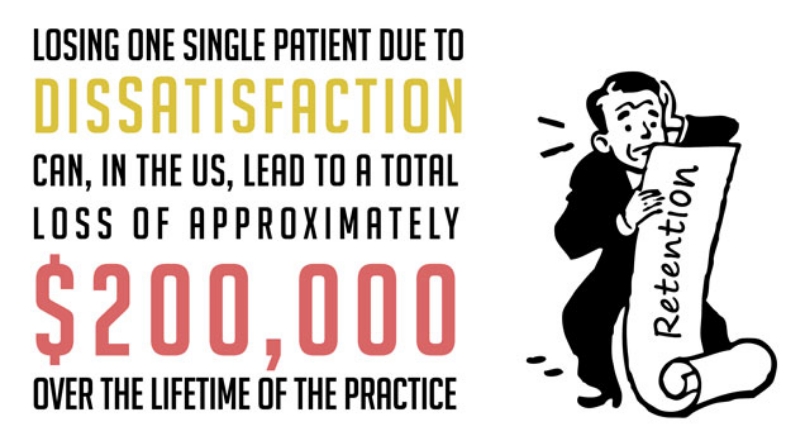
You’ll never get 100% retention (for a variety of reasons which do not necessarily reflect back upon your practice) so make sure your patient retention goals are realistic. Your staff needs to know that their employer (you) trusts them to do their job to the best of their ability, and heavy-handed policies can hurt employee retention, which will then begin to impact patient retention.
You’ll also want to have some sort of process to verify complaints, as retaining your staff also comes with cost advantages. If there is one single complaint against a staff member, it may warrant a private inquiry, but be careful not to make your employee feel targeted. Accidents happen; employees can have days or moments where they slip. In other words, utilize your common sense and your knowledge of the patient, the employee, and the situation to determine the best course. There will be instances where it will prove more beneficial to stand up for the employee against the patient.
The Miami Children’s Health System Case Study
There is a great case study to be found in Miami Children’s Health System regarding the effective utilization of negative patient feedback to counter negative reviews and drive positive change. This article, is a fantastic look at how to use patient review management to improve medical practices, and features an interview with Robert Prieto, Miami Children’s Web Marketing Manager, in order to provide a first-hand perspective of those challenges. Prieto states that when Miami Children’s had to step up their efforts to wrangle their online presence, they were immediately daunted and overwhelmed because “It was all over the place. It was a little out of control trying to aggregate all of this feedback…” Prieto emphasized that the core issues were because the reviews were on so many different sites; over the course of the interview, he mentions trying to manage the system’s reputation on five different sites (all of which, it should be noted, are on our list of six discussed in our ‘How To Choose Which Review Platforms to Focus On‘ section: Yelp, Facebook, Google, Vitals, and HealthGrades).
Gathering The Pieces
With these (and other) challenges, Prieto turned to a reputation management software to help wrangle the reviews on these various sites. The specialized tool gave Prieto and his team the boost they needed to be able to locate all of their reviews across a multitude of sites and even helped to pin down a few non-official profiles for Miami Children’s locations, minimizing confusion for patients and potential patients who were looking for them online.
Being Proactive
At the end of his interview, Prieto concluded by stating that his team at Miami Children’s is adopting a proactive mindset, instead of just being reactionary in their approach to these problems. They are focusing on addressing issues before they get out of control. This proactive stance regarding the online reputation of Miami Children’s has served the health system well. They’ve been able to gather and analyze their online reviews in a way that allows them to use the information to improve patient experiences at each of their locations.
Automated Patient Satisfaction Surveys
There is, however, one useful tool which Prieto never mentioned during his interview: Automated Patient Satisfaction Surveys. These surveys are typically sent via email or text message after a patient has left the facility and typically not until a set amount of time has passed (one or two days). These automated surveys are especially useful as tools which can allow the provider to proactively gather actionable feedback. Further, the receipt of such a survey allows a patient to air complaints directly to the provider, allowing them to feel that their voice is being heard – which means they’re less likely to post a negative review online.

This may not always work, particularly in regard to especially-livid patients, who will likely not wait long enough to receive the survey before posting their review, or who have their heart set on a public review. However, the number and impact of negative reviews does decrease significantly when satisfaction surveys are implemented.
Tools Are Only Effective With The Right Approach
Even with the boost in productivity due to the aid of the software service, though, Miami Children’s couldn’t have turned its online presence around so effectively without the proper mindset. Prieto set a system in place that prioritized negative feedback discovery and resolution, stating that when they receive a “comment about an outpatient center and the service was in urgent care, we’ll immediately send that up to the regional director for the urgent care center.” They review every negative review that comes in and compile it with others.

Analyzing Common Review Language
Periodically, every practice under the Miami Children’s banner gets reviewed, all of the reviews for a location are filtered through a program to create a word cloud, giving the team-specific words to focus on as they go back through each comment. Using the information gleaned from these sessions, Miami Children’s practices can pick out where their problem areas are and work toward improvement.
But, that’s not the end of it. There’s another crucial element to their success: direct responses and the visibility of these. But before we move on, let’s address one of the biggest concerns about bad online reviews that physicians may encounter.
Address Issues Constructively
So let’s take a moment to break this down. You have identified a problem. Now, what exactly do you do about it? How do you implement changes effectively? Here are three easy steps to get you started.
1 – Be proactive. Don’t just sit around waiting for the unhappy or angry reviews to come to you. Find ways to ask for them. This can mean offering comment cards to customers or opening up private feedback channels on your site, for example. A pack of index cards and a cardboard box decorated in your practice’s logo colors, with a slit in the top (for relative anonymity), can be a stopgap measure to something more permanent (such as the automated satisfaction surveys mentioned above) if you want to get this implemented fast.
2 – Establish procedures to act on the information received. Sure, there will be some flukes, and you certainly can’t please everybody. So maybe acting on one instance might be rash, but creating a system to track issues, flagging them so that it becomes apparent when complaints are especially serious or becoming a trend, can help to prevent these problems from becoming big enough to impact your online ratings and overall reputation.
3 – Respond to patients. No matter whether a complaint is verified or not, give the reviewer a positive response. Assure them that you take their concerns seriously and thank them for bringing their dissatisfaction to your attention.
Think Like A Patient
The perspectives of doctors and patients are remarkably different. This often has to do with the emotional stress that both are under. Even on routine primary care visits, the patient is often stressed walking into the waiting room: How long will the wait be? Am I going to miss my 2:30 meeting? What if the doctor finds something?
Let’s not even get started on the stress that parents experience in a waiting room if they are at a pediatrician appointment or just have to have the kids with them.
Doctors and their staff, on the other hand, have inherently stressful and complex jobs. Most patients will never understand the maze of red tape that the provider must navigate or the completely absurd time constraints imposed on doctors by payers. But, then, they don’t have to; doctors don’t get to choose their patients. Doctors, on the other hand, have to make every attempt to meet their patients eye-to-eye and understand their situation in order to best help them – in part because patients are likely to not heed medical advice unless they feel it comes from a place of mutual understanding.
Why Happy Patients Might Fail To Leave A Review
There are often assumptions made that happy or satisfied patients (or customers in any industry) don’t leave reviews. Often, these assumptions lead businesses to the belief that happy patients are not willing to leave a review online, but that is just not the case. Rather than allowing these assumptions to take root in your mind, or the minds of your staff, pause and think like a patient for just a little longer.
- They intended to leave a review and forgot.
- They would leave a review but don’t have or make the time to go through the motions.
- They prefer privacy and don’t like calling attention to themselves, even in largely anonymous formats.
- They don’t feel like their one review really matters to your business.
- They were relatively satisfied, but they just don’t like going to the doctor, or hospital.
- They had a middle-of-the-road experience.
- They went online to leave a review and got distracted, or perhaps it wasn’t clear where to go to leave a review. Sometimes this problem is aggravated by multiple profiles for the same practice or hospital.
- The thought of leaving a review simply never crossed their mind.
- They are just too busy.
- They did leave a review, but did so on an obscure healthcare review site you’ll likely never hear of.
Most of these can be remedied easily as part of your reputation management campaign. Give them reminders, ask them and let them know that their feedback means a great deal to you. Show or tell them where to leave the review, and the majority of these reasons for satisfied patients not leaving a review are gone.
How Feedback Influences Patient And Provider Communication
There is a telling study that was performed in Italy, published in 2014, which looks closely at the influence of negative feedback in patient satisfaction surveys – particularly with how this influenced patient/provider communication. The study utilized surveys (of staff and patients) in 26 publicly owned Tuscan hospitals and analyzed the results to determine how awareness (by staff) of patient experience influenced overall patient satisfaction scores.
What they found was that for every percentile point of understanding and awareness by staff, patient satisfaction scores averaged 0.35 percent higher. In other words, a ten percent increase in awareness by staff results in a 3.5% improvement in patient satisfaction.
This may seem like a small return. Trivial, to some. But it can make all the difference in the world when you have those extra few happy patients. That means fewer negative reviews (and more positive ones), fewer tense standoffs between your patients and receptionists, and more open and receptive patients in the exam rooms.
It All Adds Up
A 3.5% jump in satisfaction may, again, not seem like much, but as we covered above, one lost patient means hundreds of thousands of dollars lost. Further, as we’ll expound upon in a moment, there are other problems with low patient satisfaction ratings, as some are used for official purposes. The Centers for Medicare and Medicaid Services (CMS) released a new five-star patient satisfaction rating system in 2015. It was clear that the data showed that most hospitals have low patient satisfaction scores.
At that time, reflecting on scores for 2014, only:
-
251 Hospitals (7%) received a five-star score for patient satisfaction
-
1205 Hospitals (34%) received a four-star score
-
Only 41.6% of all hospitals in the US received at least four stars
More recent data, released in 2018, shows a decline in hospital ratings:
-
213 (6%) received five stars
-
1177 (34%) received four stars
-
Only 40.1% received at least four stars

What This Means For Your Healthcare Business
Standards are going up, and patients are growing ever more internet savvy. New technology allows them to highlight problems for everybody to see. This could affect your patient base and your funding…
BUT, this could also give you an advantage if you take action and emphasize quality and patient satisfaction.
If all healthcare providers garner good reputations, then becoming the preferred choice for patients will rely on more and more minute criteria. Every little detail will matter, and a solid management plan remains one of the best tools to keep existing patients and draw new ones. As the article from AAAHC from earlier mentions:
Every new patient has to be reached via some form of advertising, and very few of those are free – not even online reputation management (somebody has to be paid to handle that as one of their duties; however, it is still often cheaper than online or traditional advertising). Good reputation management, though, has a firm positive effect on a healthcare provider’s bottom line.
An NIH-sponsored study from 2010 which focused on patient experience and satisfaction and their effects on the industry, specifically cited the effect of satisfaction on a practice’s ability to be consistently profitable, which puts even established healthcare businesses in jeopardy.
As we mentioned, a loss of a patient due to dissatisfaction can result in the loss of over $200,000 in income over the lifetime of the practice.
Of course, the size and specialty of your organization can move the needle on this. But even if your business does not take such a massive hit from losing a patient. Let’s say you stand to lose only 20% of this figure, that’s still a hefty $40,000.
This loss can accrue in literally dozens of ways. When you lose an existing patient, you also lose everything you have, thus far, invested in that patient (initial attraction costs from advertisements, etc, plus every interaction with or about that patient after that point – whether the interaction is with the patient, a previous physician, a pharmacy, a specialist, a lab, or a payer, there is an investment being accrued); you may fail to attract new patients; your patients may be generally less happy, meaning more difficult work for your staff, meaning higher turnover and associated costs. The list goes on. The point is that patient satisfaction can (and does) have a serious impact on your practice’s bottom line.
And these aren’t even including the most obvious reason for financial impacts.
Responding to Negative Online Reviews
t comes to patient reviews, it’s crucial to let people know you’re listening. And that you’re doing so on a regular basis.
It goes without saying that posting a response months or years after a review is posted is less effective. If you’re wondering if it is ever too late to respond to a review, the answer is no, however you should strive to respond to all reviews within a few days of posting.
Three Ways To Respond To Bad Reviews
There are a lot of different approaches to this. This article will detail your options along with the pros and cons of each, however, we will not tell you which one is right for your business. Your audience, specialty, and company values will help you to determine which approach is best for you.
It is also worth noting that there are no rules that say you have to stick with a single approach. Many medical organizations prefer to have a toolbox of response options and use the one that is most appropriate for the specific situation that an individual review presents. Here are the three main options.
- A Generic Response

This is a response to a bad Google review from a hospital patient. The response is a generic reply that does not specifically address the comment from the review. Instead, it states the values of the organization and encourages the patient to call to speak with someone about their experience.
The benefits of a generic response like this are that:
- You avoid any legal issues that may arise from speaking about the specifics of the situation publicly.
- You give the unhappy patient a way to talk to someone about what happened and remedy the situation.
- Others who have negative reviews to write might choose to just call, rather than spending time writing the review.
- Potential patients who see the negative review also immediately see that the provider is interested in correcting the issues which has a mitigating effect on the negative psychology of bad reviews.
Of course, the downside to this approach is that it is very clear that this reply is pre-scripted.
2. Response Templates
A more flexible variation of this approach is a modifiable template response. This is when you take the basic approach above and modify it to include a few details, such as the reviewer’s name and a detail or two from the review comment. Here’s an example of what that response might look like for the example above:
“Hi Mary, we regret to hear of your need for a return visit. You and your family’s experience is important to us. Please contact our Patient and Guest Relations Department at 786-624-4400 to speak with a representative.”
This is a little more personal without getting into the nitty-gritty details of the comment itself. This is a versatile and effective approach that doesn’t take up too much time and helps the reviewer, and your readers, see that you actually read the comment and that you’re not a robot.
3. A Personalized Response
The third option is the most in-depth and flexible. This is a reply that is crafted specifically for the comment. In the example above that response might look like this:
“Mary, we regret to hear of your need for a return visit for your daughter’s injury. You and your family’s experience is important to us and we strive to eliminate the need for return visits as much as possible. Your feedback is important to us and we appreciate you bringing your experience to our attention. Please reach out to our Patient and Guest Relations Department at 786-624-4400 to speak with us about how we can improve our services for the future.”
In this response option, it is extremely important to craft your message carefully. Avoid doing any of the following:
- Discussing details of a visit or patient information. HIPAA compliance and legal issues can pop up if you’re not careful.
- Accepting blame. Doing this may open the door for legal issues.
- Telling the patient that they are wrong, or implying that you don’t believe them. Even if you have undeniable evidence that what is written in the review is untrue, it is always a bad idea to approach a review this way (at least, in healthcare – other industries can get away with pointing out bad faith reviews a little more easily; for why, refer back to #1).
- Asking the patient to provide more information publicly. If you feel that by providing more information would help you help this patient, or your future patients, speak to the reviewer about their experience privately.
- Pointing out contradictions. Even if the reviewer contradicts themselves a hundred times, don’t point it out.
- Being defensive.
Remember, the purpose of reviews is to help you help patients. No matter how negative the review is, always appreciate that the writer took time out of their day in an attempt to be heard, help future patients, and help you understand what they went through. So, don’t take it personally.
Let’s look at one more example of how to best handle a negative online review with a personalized reply.
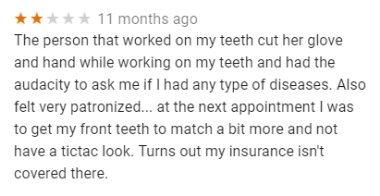
A good response might be:
“John, thank you for your feedback, it’s very important to us. I am sorry to hear about your unpleasant experience. I understand that you felt patronized at your visit and I can assure you that we always strive to provide the most professional, comfortable, confidential and safe experience for all of our patients, as well as our staff. I am also sorry to hear your insurance was not accepted at your following visit. We accept most dental insurance plans and our goal is to provide exceptional dental care at an affordable cost regardless of your insurance plan. Please contact us at 555-555-5555 and we would be happy to help with any of your insurance concerns or questions and find affordable options for your needs.”
Tone and Language of A Negative Review Response
The feeling behind your response is crucial in showing your patient that they are not only heard, but that you care about his or her health, time, and happiness. Remember that even reviewers who go on a rant about their seemingly terrible experience are good people; they just want what’s best for their health, their families, and their lives.
More importantly, they chose you for their medical needs because they trusted you. In many cases, the patient is upset because they feel that trust has been broken. The patient may feel betrayed, inconvenienced, misled, and/or unimportant to you. They may just be looking for some empathy and understanding. It’s crucial to keep this in mind when responding to a review.
Bad faith reviews do exist, but it’s always best to assume sincerity in your initial response.
Here are a few tips:
1. Always thank the reviewer for their feedback
2. Acknowledge their sentiment
3. Acknowledge their issue
4. State your values
5. Offer assistance
6. Explain the reasoning behind what happened (depending on the situation)
Before we move on, let’s cover one more example of how to respond to a bad review with empathy. Take this review for instance.
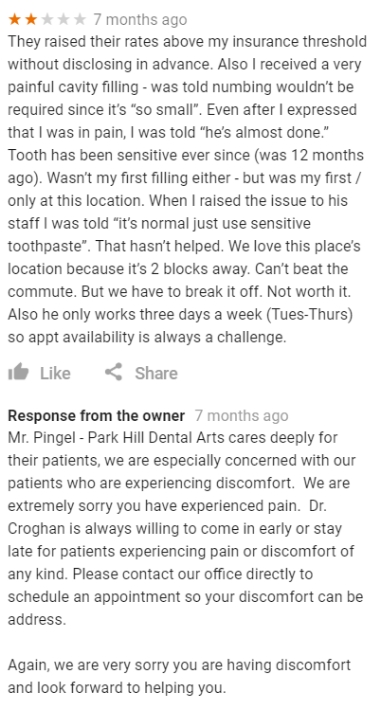
This reply is genuine, caring and kind. It shows that the provider really cares about this patient and is willing to do what it takes to help him. The apology is authentic without implying that anything went wrong during the visit.
Responding to positive reviews
After carefully crafting replies to bad feedback, responding to positive patient reviews is a walk in the park. But don’t let that mislead you. Responding to positive reviews is simple, but important!
Imagine that you went to your favorite cafe and told the waiter, “You always do such a great job.” You’d expect a smile and a “Thanks.” But what if he just turned around and ignored you? You’d probably feel a little offended, or at least unappreciated.
It’s the same with positive reviews. You’re receiving a compliment, so say thank you!
Here’s an example of how to respond to a positive patient review:

Chapter 8
How To Handle Fake Patient Reviews
When it comes to online reviews, fake reviews are a doctor’s worst enemy. Yes, they can happen to anyone. But the good news is, fake reviews are not as common as you might think, and not always negative. Even better, they are only as damaging as you allow them to be.
What Can You Do About Fake Reviews?
There are known cases of false reviews being posted in order to trash competitors’ online ratings, though these are not as common as you might think. Both Facebook and Google have ways of shutting down fake reviewers, so anyone trying this approach likely won’t get away with it for long.
It may also be that patients, or people who have never visited your medical office leave reviews that are exaggerated, out of context, or otherwise inaccurate. Often times reviews that cannot be verified are likely to be written off as unimportant, but remember, most people who come across you online will think otherwise.
Can You Get Fake Reviews Removed?
It’s worth a shot, but it’s rarely successful. When it comes to fake reviews, no matter how inaccurate they may be, the best approach is to respond to them as you would a genuine review. Then, to get more good reviews to decrease the impact of the falsified one.
Do you have a misleading or fake review? Here’s how to remove a false online review:
1 – Respond: Remember to always be calm and professional (if you’re worked up, have somebody else you trust review your response for tone before posting!). You may consider presenting a few details about why the review cannot be verified (i.e. “You mentioned getting a CT scan, however our location does not offer this service.”)
2 – Alert the Host Site: Whether it’s Google, Yelp, Facebook, or any other, there should be a mechanism to notify the company. Since Google is the dominant review site we’ll focus on them. On Google, if you can report a review by clicking the flag icon next to the reviewer’s name to report the review as a violation of Google’s Terms of Service.
3 – Call Google: Wait 24 hours, and if the review has not yet been removed, then give Google a call. Go to business.google.com and locate your business’ listing. From there, look for the hamburger menu icon (three horizontal lines), click it, and locate “support”. You’ll need to be ready to provide evidence that the review is fake, but you can use this to speak with Google support via chat or phone.
4 – The Nuclear Option: If you go through steps 1-3, and nothing is done, you can still try the legal route. You can submit a legal removal request at support.google.com/legal. Check in on the case regularly, and you should be able to get the review pulled.
No matter the legitimacy or the sentiment behind a review, sweeping it under the rug is not an option. A response is the best approach, so let’s talk about how to write your review responses.
Chapter 9
Increase Patient Satisfaction To Improve HCAHPS Scores
Patient Satisfaction At Hospitals Needs Help
Given the current ratings and the data we have about how patient experience and perception affect opinions, numbers should be going up.
But, patient satisfaction in hospitals and the healthcare industry isn’t so simple, as the above linked article from The Hospitalist demonstrates. This article is from 2005, and slightly outdated, but the sentiment remains largely unchanged.
Many people still compare hospitals to VW buses, elephants, or leeches for varying reasons. Those comparisons all come directly from the American Hospital Association’s Reality Check, an official survey conducted within the years before the article was published. That article also draws on statistics from the American Customer Satisfaction Index, which gave hospitals an overall 67% satisfaction rating.
Hospitals ranked 27th out of 31 industries.
What does that boil down to?
In 2018, the benchmark score for hospitals is up to 76%, a solid improvement, but still only ranked 26th of 40 industries rated that year. Interestingly, this is the same rating given to the IRS by “individual e-filers”.
The net improvement in how hospitals are viewed by consumers is heartening. Continued positive trends could mean that reputation management becomes marginally easier.
As people age, their health deteriorates, their medical costs rise. These are, simply put, factual trends. ‘Trends’ because there are some who seem to gleefully spit in the face of time and defy some of the basic fundamentals of mortality (I’m looking at you, Grandma Sandy). But eventually, even those spartan souls get sick.
Elders will always need more medical attention than the general population. Aging adults are also the bulk of recipients of Medicaid and Medicare. The difficult thing about these single-payer programs is that there is a measure of quality control implemented.
Your revenue suffers if your patients tell CMS (Centers for Medicaid and Medicare Services) that your practice isn’t worth going to. These CMS Scores, or HCAHPS (Hospital Consumer Assessment of Healthcare Providers and Systems) Scores, can have severe impacts on a healthcare provider’s bottom line; this means that working to improve HCAHPS Scores, year-over-year, should be a primary concern for any practice, but especially those which have a disproportionate skew toward an older patient base.
 Note:
Note:
When discussing these scores, CMS is the organization that oversees Medicare/aid; HCAHPS is the survey, specifically.
How important are HCAHPS scores?
To better understand why HCAHPS scores are so important, let’s look at a few facts and stats:
-
According to the HCAHPS Fact Sheet, “in July 2017, 4,315 hospitals publicly reported HCAHPS scores based on more than 3.1 million completed surveys.”
-
The fact sheet states that, on average, at least 8,400 patients respond to the HCAHPS survey daily.
-
No other patient satisfaction survey has such a direct effect on a provider’s financial well-being, with up to 2% of all Medicare/aid reimbursements at risk as of the fiscal year 2017
-
For a health system such as Vidant Health, a nine-hospital system with 1,488 beds and $1.6 billion in the fiscal year 2013 operating revenue, 2% can mean millions of dollars saved — $32 million, to be exact, for the given numbers for their FY2013.
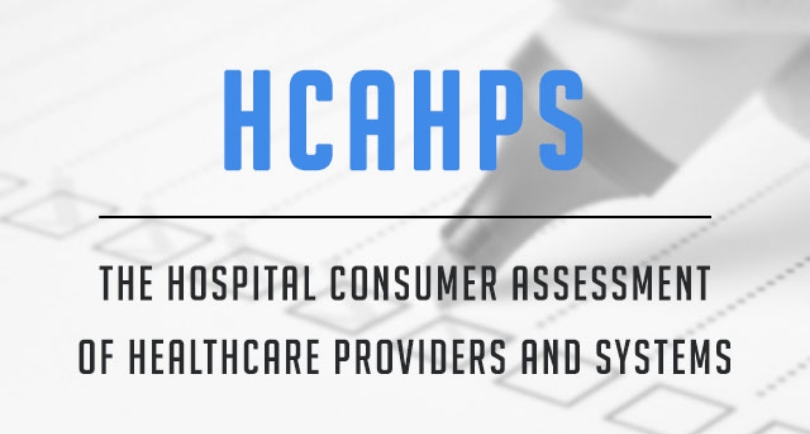
HCAHPS surveys are required by CMS for any provider who wishes to accept Medicare or Medicaid payments. This means the surveys are required for effectively every provider. There is not much you can do to get away from or around it.
Understanding What The HCAHPS Asks
Fortunately, the questions asked in the survey address very basic, common patient satisfaction concerns. They are the sorts of things that most practices already endeavor to control and that any physician’s reputation management plan already in place is at least moderately aware of. Still, the first thing that anybody looking to improve HCAHPS survey scores should do is check out the questions.
Some of the biggest topics of these questions include…
-
How well/often did doctors/nurses communicate?
-
Were patients helped quickly/efficiently?
-
Was pain management an issue?
-
Were medications/treatments properly explained?
-
Cleanliness/Hospitality/Environment/Noise
-
Overall rating/recommendation
How can online reviews improve HCAHPS scores?
When patients leave negative reviews online, the topics that the HCAHPS surveys cover are often discussed. Ergo, good reputation management programs can identify and help correct these issues more quickly than waiting for HCAHPS scores.
As discussed previously, patients and providers often have entirely different experiences, and perceptions of said experiences, within a practice and during appointments. For the provider, it’s just another day of work; for the patient, the experience is, typically, abnormal to their routine.
To underscore this, and better illustrate how these different perspectives can affect review scores and the HCAHPS survey, check out the story of Cathy Frontczak (starts at the bottom of page 2; this article was linked earlier, but this link goes directly to page 2), Chief Nursing Officer and Vice President of Patient Services at St. John’s Hospitals, based in Oxnard California, and a subsidiary of Dignity Health (39 hospitals and over 400 other care centers in AZ, NV, & CA).
St. John’s was in the bottom quartile for HCAHPS scores within Dignity Health in 2010 and 2011, but after utilizing what she noticed during an experience while her mother was hospitalized – noticing the impact that excess noise could have on patients – Frontczak implemented new policies that helped to bring St. John’s up to Dignity’s top quartile.
Doctors and nurses tend to be busy. They intend to give good service, but may come across as curt; they may see a mess, intend to do something about it, but something comes up that takes precedence. These problems cannot be addressed as they arise — that’s a reactionary approach and is ineffective at preventing problems. It is response driven and many medical providers find themselves caught up in a whirlwind of reactionary necessity throughout the majority of their day.
Throughout the day-to-day whirlwind it’s hard to see past the metaphorical storm you’re struggling to control.
Negative Patient Feedback Seems Inconsequential When You’re Busy Saving Lives
Negative feedback can seem particularly trivial if you put it into the context of the day-to-day storm. A lot of us might think to ourselves, “What good will listening to complaints do when we’re all already doing as much as we can?” It might seem backward but feedback is one of your best tools to conquer the whirlwind.
Patient feedback can point out where consistent issues are so that improvements to policy can be made, such as dry-erase floor maps which can be labeled with locations of spills or other issues so that it gets addressed more quickly (for a low-tech solution example).
Negative feedback can make your job easier, by helping you conquer inefficiencies. It can also save you time and eliminate the stress of having to listen to patient verbally complain of an issue on a daily basis.
For example, patients may ask the nurse to turn up the thermostat, maybe you could adjust the thermostat each time, only to have to move it back up to baseline later. Or maybe that’s a big waste of time and energy. Maybe it’s time to invest in some blankets or to suggest to your patients that they bring a sweater to their appointment. Without feedback, you can’t quantify the issue which means you can’t find the best solution.
The problems that necessitate these solutions can be discovered through the HCAHPS responses, but HCAHPS surveys do not provide the same level of detail that can be found in text-based feedback since they’re just numerical scores. Online reviews, on the other hand, tend to provide much more detail of events and circumstances (albeit biased) than a one-through-ten rating does. Finally, in the months or years it takes to fully decipher the exact problems and correct them based purely on HCAHPS scores, potentially millions of dollars have been lost.
Proper reputation management accelerates the process of locating specific problems in specific departments and finding ways to resolve these costly issues.
To make things worse, HCAHPS scores and reduced reimbursements aren’t the only potential costs due to problems going undetected. There is always the potential for (pardon my language here) lawsuits with particularly unfortunate incidents. To be fair, the worst of these tend to involve malpractice, and it’s not likely that you’ll first discover a surgeon who chronically sews up patients with foreign objects inside on Yelp.
However, there are other issues that might seem like irritations to some, who give poor ratings in response, but others find them to be — rightly — worthy of a lawsuit. A particular resident who doesn’t always knock before entering; a new janitor who steals things from patient rooms; a nurse who gets irritated easily and practices small cruelties.
Patient Feedback Helps Identify And Prevent Medical Errors
Then, there are the simple issues which cause medical errors.
Approximately 86% of mistakes made in the healthcare industry are administrative, and these preventable medical errors claim approximately 400,000 lives every year in the US alone. If the family of a patient who dies due to errors in paperwork finds out, they will not hesitate to sue. Therefore, if there are reviews online citing any sort of administrative or paperwork error which made the process less pleasant for that patient, then it is a lawsuit waiting to happen. Eventually, one of these errors will fall into the category of “a big deal” (at the least), or life-threatening or resulting in a death (at worst). No administrator or doctor wants that, nor do they want the suit that follows.
Not convinced? Let’s look at just a few of the most important statistics from the link above.
-
One of every five malpractice claims cite misdiagnosis or delayed diagnosis due to delays in communication and paperwork transfers between providers.
-
Approximately 25% of patients have reported that their medical records from one provider did not reach a second provider in time for an appointment.
-
Approximately 80% of errors which trigger a waterfall effect involve miscommunication, including informational exchanges between providers and verbal exchanges between colleagues.
-
Similarly, 80% of serious medical errors occur as a result of some form of miscommunication during care transitions.
-
In 2013, only 41% of hospitals reported being capable of communicating with their providers electronically.
-
It costs, on average, over $8 to process a single transaction, largely because half of them are faxes. Part of the cost is due to the inefficiency of the system. Thus, to process 30 billion transactions will cost at least $250 billion.
Because communication is so vital, it is becoming more critical than ever that these systems be overhauled. To save money on basic expenses, time wasted, and to avoid potential lawsuits, it is advisable to ensure that your practice (and others within any networks that you may be part of) has reviewed and ensured that the communications methods being utilized are as efficient as possible.
Not all communication issues can be avoided. However, a good system which allows for your practice to receive private feedback, monitor online reviews, or both, can help to underscore any inefficiencies or problems that may exist in your system or methodologies – and hopefully, before any lawsuits come out of these things. One lawsuit can negate a lot of financial gain in fighting or settling, not to mention the long-term damage to your practice’s reputation. It’s best to solve the problems before they occur.

What Happened To The Virginia Mason Medical Center?
In Virginia Mason’s case, accreditation was never fully revoked, as the hospital managed to correct the twenty-nine areas in which they had failed their compliance check.
But Virginia Mason had failed compliance in twenty-nine areas. The fact that this is still a fairly small percentage of the total standards that the Joint Commission investigates means that it is extremely hard for any provider to meet the Commission’s exacting standards on each and every one.
And the Joint Commission’s standards are strict, as Gale Robinette, a spokesman for Virginia Mason, illustrated to the Seattle Times when they were denied accreditation.
Robinette used the citation on their fire drills for her example (refusing to speak on the others, as this was likely the most publicly acceptable example). Virginia Mason does, of course, have fire drills, she stressed, but “in the view of the Joint Commission surveyor, there should be more variability in the scheduling of our drills.” This may seem trivial at first, but these stringent standards have beneficial effects on outcomes.
Meeting Joint Commission Standards Can Be Made Easier With Good Reputation Management
Among worldwide peers reviewed in this study, published in 2010, the Joint Commission (referenced here by their now-outdated acronym, JCAHO) had the best results. The Joint Commission’s standards, however, just like HCAHPS surveys, have a lot of crossover with what patients are concerned about.
The effects are circular — implementing solid reputation management and feedback collection systems can help to safeguard providers from the possibility of these massively negative effects, which means higher initial reputation and easier management. Whether the concern is with HCAHPS, lawsuits, or accreditation, maintaining that patient-oriented focus which brings in good reviews helps to offset the potential of these larger problems arising to cost the practice significant sums of money.


